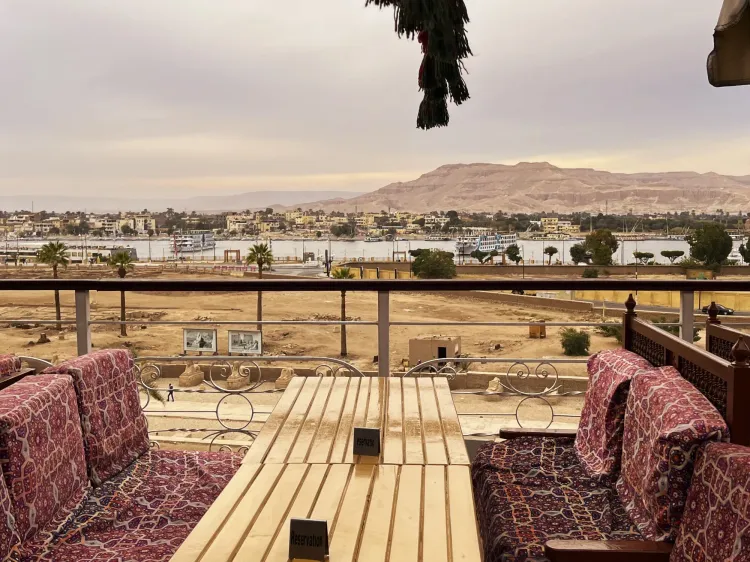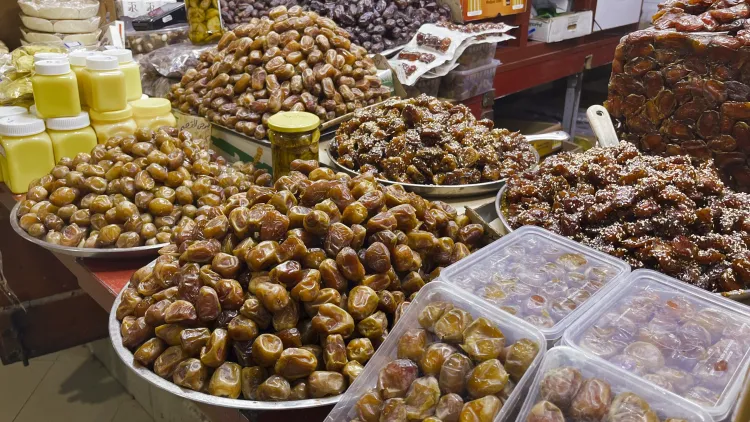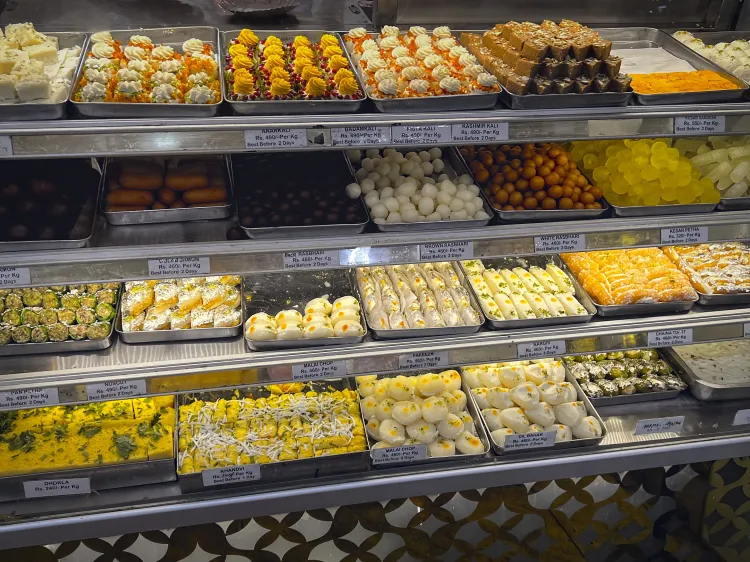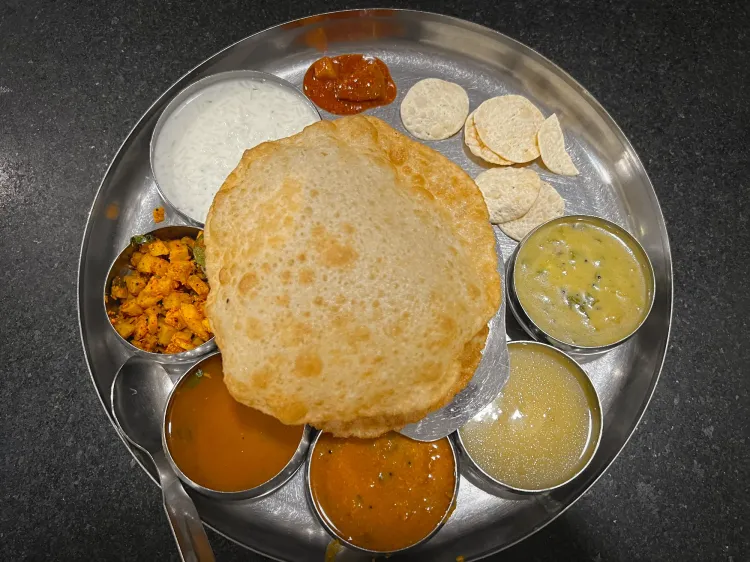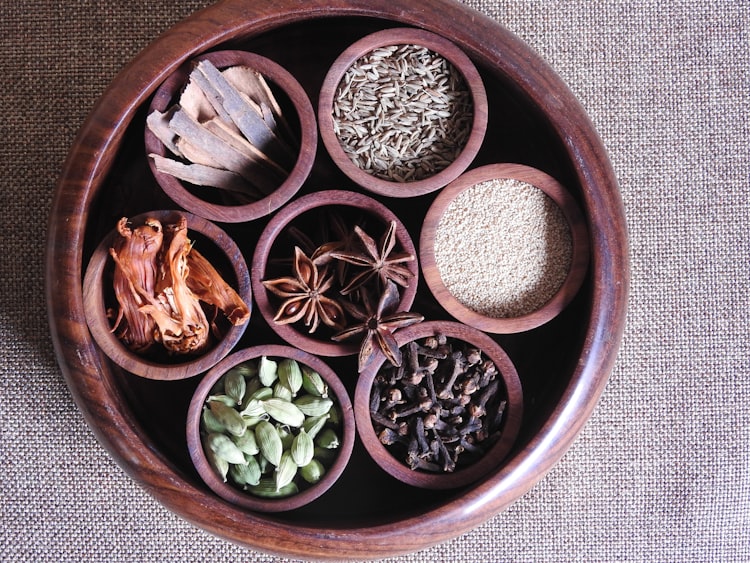Indian Gastronomy (Pt. 1 - Northern India)
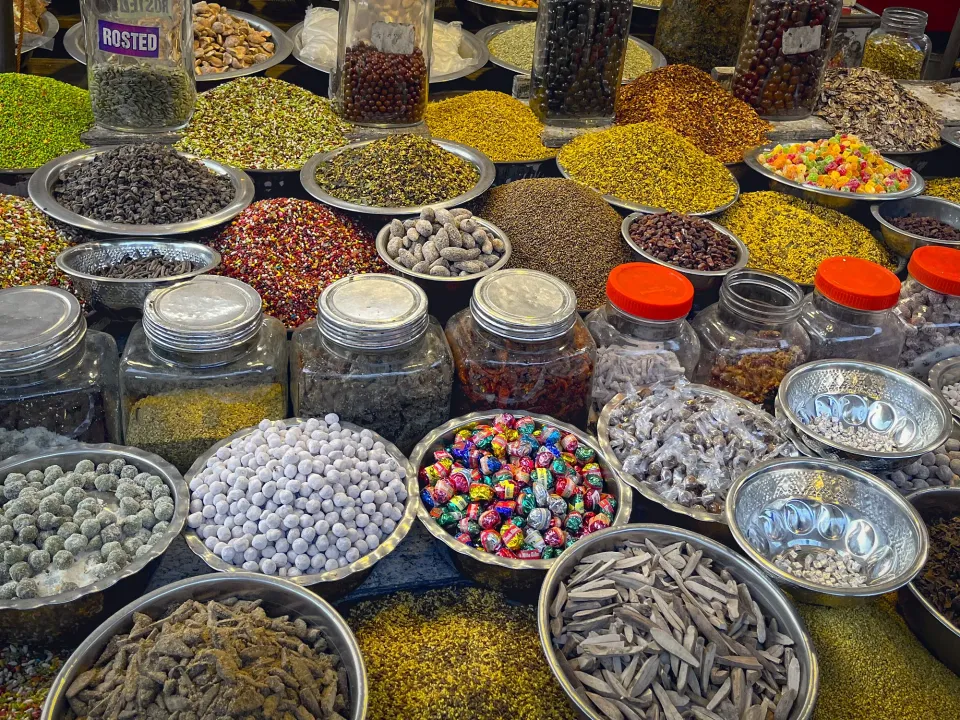
Indian gastronomy is one of the most influential cuisines on the planet. Thanks to the geographical variety and heavy uses of spices, the breadth and complexity of flavor of Indian food is absolutely incredible. From curries and breads, to lentils and stews, to heat galore, it is no wonder why Indian food is one of the most popular and beloved cuisines of all time.
India is one of the largest and most diverse countries in the world. Due to its sheer size, extreme regional variation, and depth of gastronomy, reviewing all of India in a single article would be completely overwhelming. India is most colloquially grouped together as North India and South India. Officially, it is divided into 6 zones: Northern, Central, Eastern, North Eastern, Western, and Southern. For the purposes of these gastronomy reviews, we will talk about India in 4 parts: Northern/Central, Western, Southern, and Eastern/North Eastern.
In Pt. 1, we will review Northern Indian cuisine. North Indian cuisine is known for its curries and breads. These curries are usually extremely rich and heavy, and are what many people outside of India think of as Indian food due to their popularity in international restaurants. Because of this, we will see many international hits in this section, and it will most likely be the longest part. There is a reason that North Indian cuisine has become so popular internationally, aided in part by their high ratio of butter/ghee/oil, as it certainly has some of the best tasting dishes ever created.
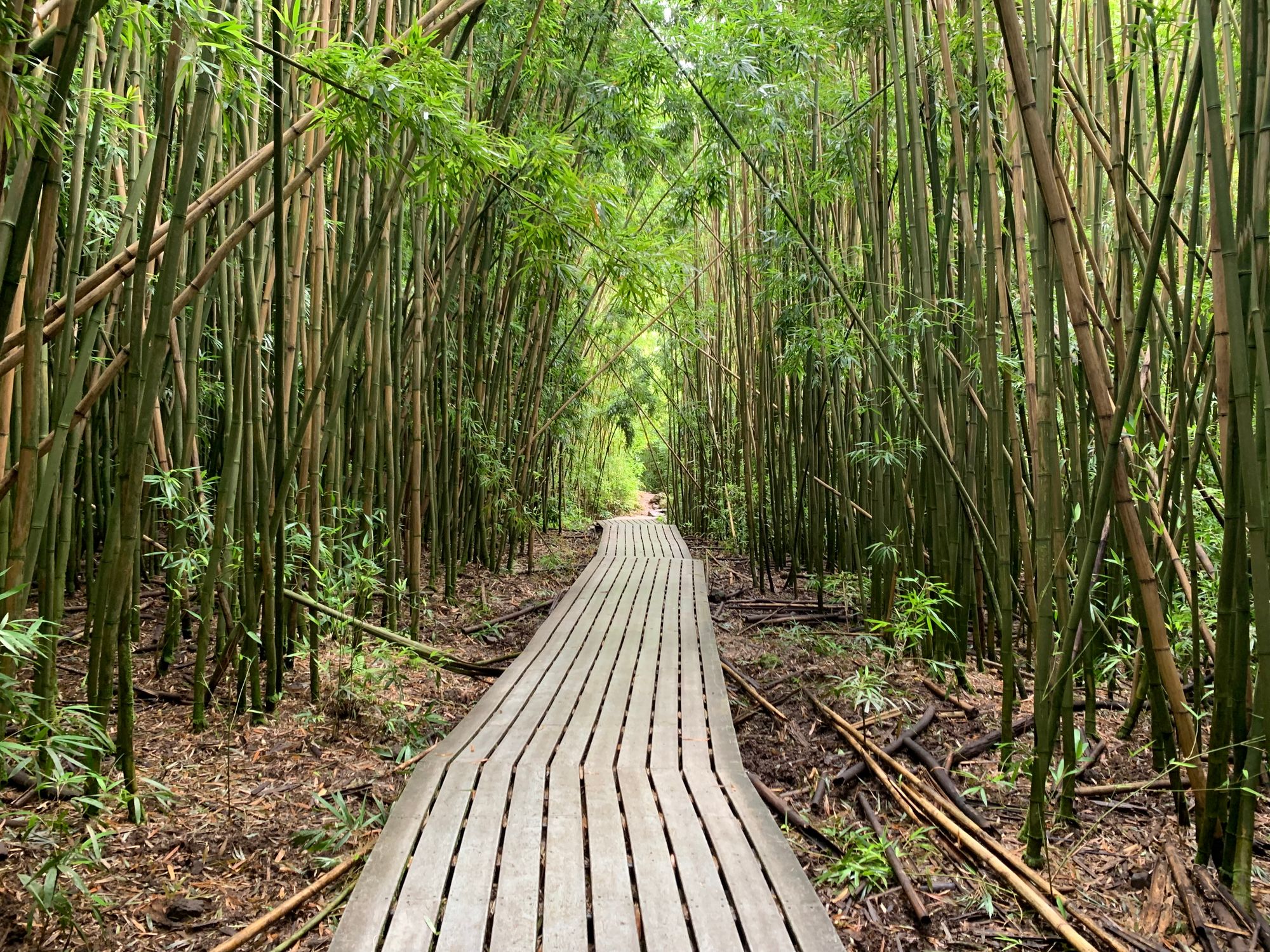
Culture and Geography
History
India is one of the powerful ancient civilizations, having been around since the transition to agriculture thousands of years ago. India began with varying rules and dynasties primarily within the sub-continent: starting with the Vedas from Central Asia / Punjab, the Maurya Empire from Northern India, followed by the famous Gupta Empire, ending with the Tripartite struggle in the North and a series of empires (most notably the Chola) in the South. I say "ending" here not by any means because Indian empires and dynasties stopped in the 13th century with the decline of the Chola, but because this is when the subcontinent's primarily self-contained struggles are introduced to overwhelming external influences.
India had been trading and having a profound impact on the Middle East for most of the classic and medieval periods. The Middle East reciprocated this impact on India in a much more drastic way starting in the early modern era. Islamic conquests of Northern India began around the 13th century. These were held off by a resurgence of powerful Hindu states like Mewar in Rajasthan, but by 1556 the Mughal Empire had officially established rule in India. It was during this time that India received a large dose of Middle Eastern / Persian influence. Most of North Indian cuisine is based on the intermingling of these two major cultures during this period. New sets of ingredients, a shift towards rice as a staple of the Indian gastronomic identity, and the introduction to a wide variety of milk-based sweets completely morphed Indian gastronomy into what it is today.
India eventually ousted the Mughal Empire from its long rule, only the be replaced by the British shortly after. At the beginning of the colonial period, it was the Portuguese who had first established trading posts in India, most notably Bombay / Mumbai, and a territory in Goa. Additionally, the Dutch and the French also began to develop territories in India, but these territories were limited in scope and influence. While the Portuguese have significantly influenced the cuisine and culture of Western India, the East India Company, aka the Great British Empire, was the predominant colonial force in India. The British came to rule almost the entirety of India/Pakistan for hundreds of years (over a hundred years of partial rule, with a period of direct rule under the British Raj from 1858 to 1947). They brought tons of new ingredients from the Americas to finish enriching Indian gastronomy to its modern form. Finally, India gained its independence in 1947, splitting with Pakistan, and has remained that way since.
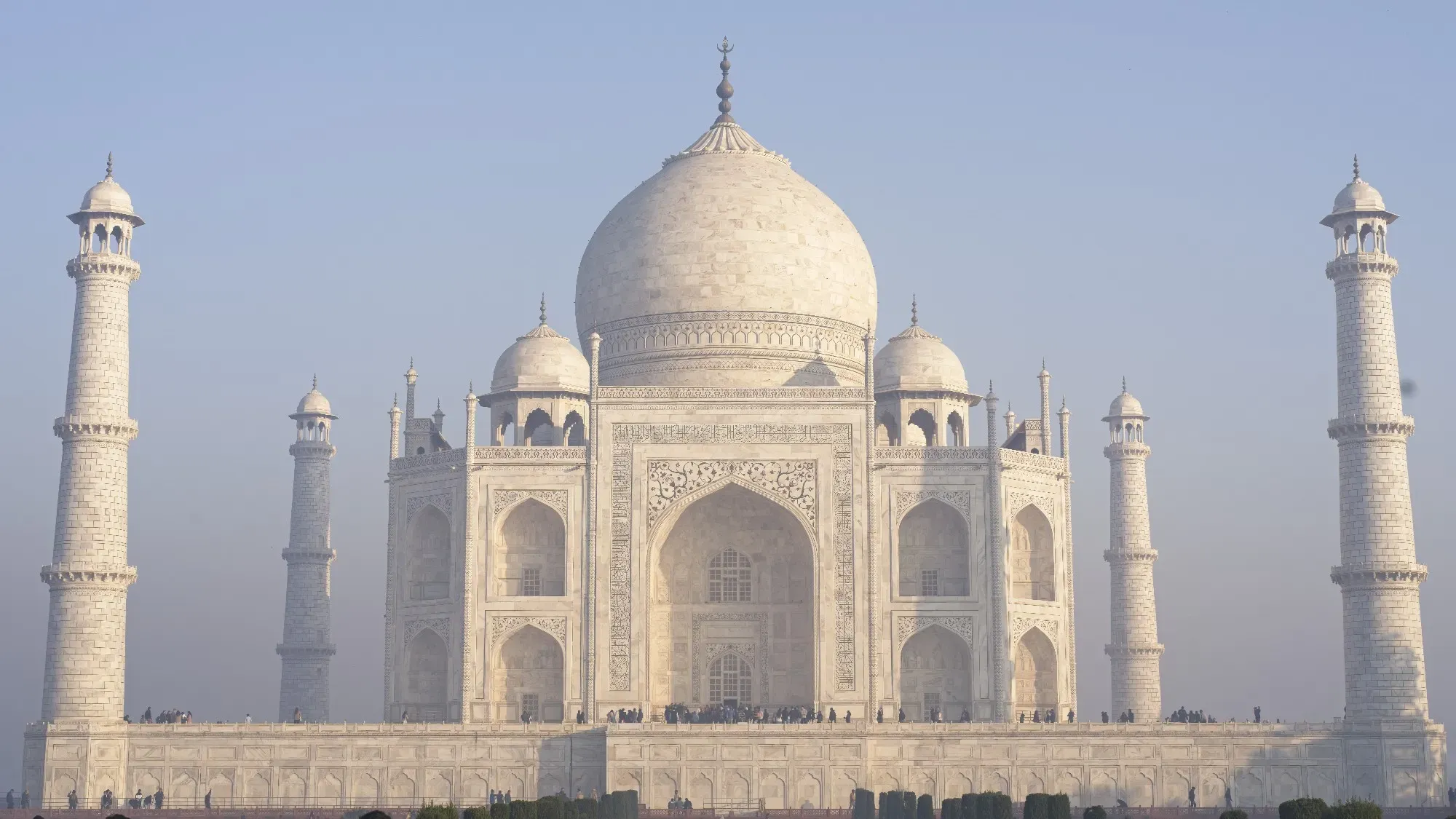
Regions
The regions that define Northern India are Chandigarh, Chhattisgarh, Delhi, Haryana, Himachal Pradesh, Jammu & Kashmir, Ladakh, Madhya Pradesh, Punjab, Rajasthan, Uttarakhand, and Uttar Pradesh. Punjab is arguably the most famous from a gastronomic point of view, as Punjabi food has utterly dominated both the Northern Indian and the international Indian restaurant menu.
Regions
Chandigarh
Chhattisgarh
Delhi
Haryana
Himachal Pradesh
Jammu and Kashmir
Ladakh
Madhya Pradesh
Punjab
Rajasthan
Uttarakhand
Uttar Pradesh
Ingredients
India has one of the world's largest ingredient list, as a key feature of the cuisine is spices. As can be seen below, there are so many spices in the Indian kitchen, and they are used in everything. An important note would be masala. Masala, translated as "spices", refers to a specific mix of spices that is used frequently in many dishes.
Most famously for North Indian food, Garam Masala is a mix of cinnamon, mace, peppercorns, coriander seeds, cumin seeds, and cardamom pods. Additionally, North Indian cuisine has a few unique spices such as amchoor (dried mango powder) and dried fenugreek.
Major Spices
Garam Masala
Chaat Masala
Ajwain
Amchoor (dried mango powder)
Asafetida
Cardamom
Coriander
Cumin
Curry Leaves
Dried Chilies
Indian Bay leaves
Fennel Seeds
Fenugreek
Mustard Seeds
Tamarind
Turmeric
Star Anise
Beans and legumes are popular throughout India. Lentils, black lentils, chickpeas, split yellow pigeon peas, and mung beans are popular protein sources in many dishes throughout India. While rice is also used throughout India, Northern India is much more known for its breads. A typical Northern Indian curry might be served with rice, but will also frequently be served with bread to scoop up the curry. Finally, dairy creams and blended nuts are featured prominently in Northern Indian food to make these decadent curries.
Major Ingredients
Lentils
Chickpeas
Mung Beans / Green Gram (called Mung Dal)
Black Lentils / Gram (called Urad beans)
Split Yellow Pigeon Peas (called Toor dal)
Ghee (clarified butter)
Achaar (Indian pickles)
Mustard Oil
Yogurt
Paneer
Basmati Rice
International Highlights
Murgh Makhani (Butter Chicken)
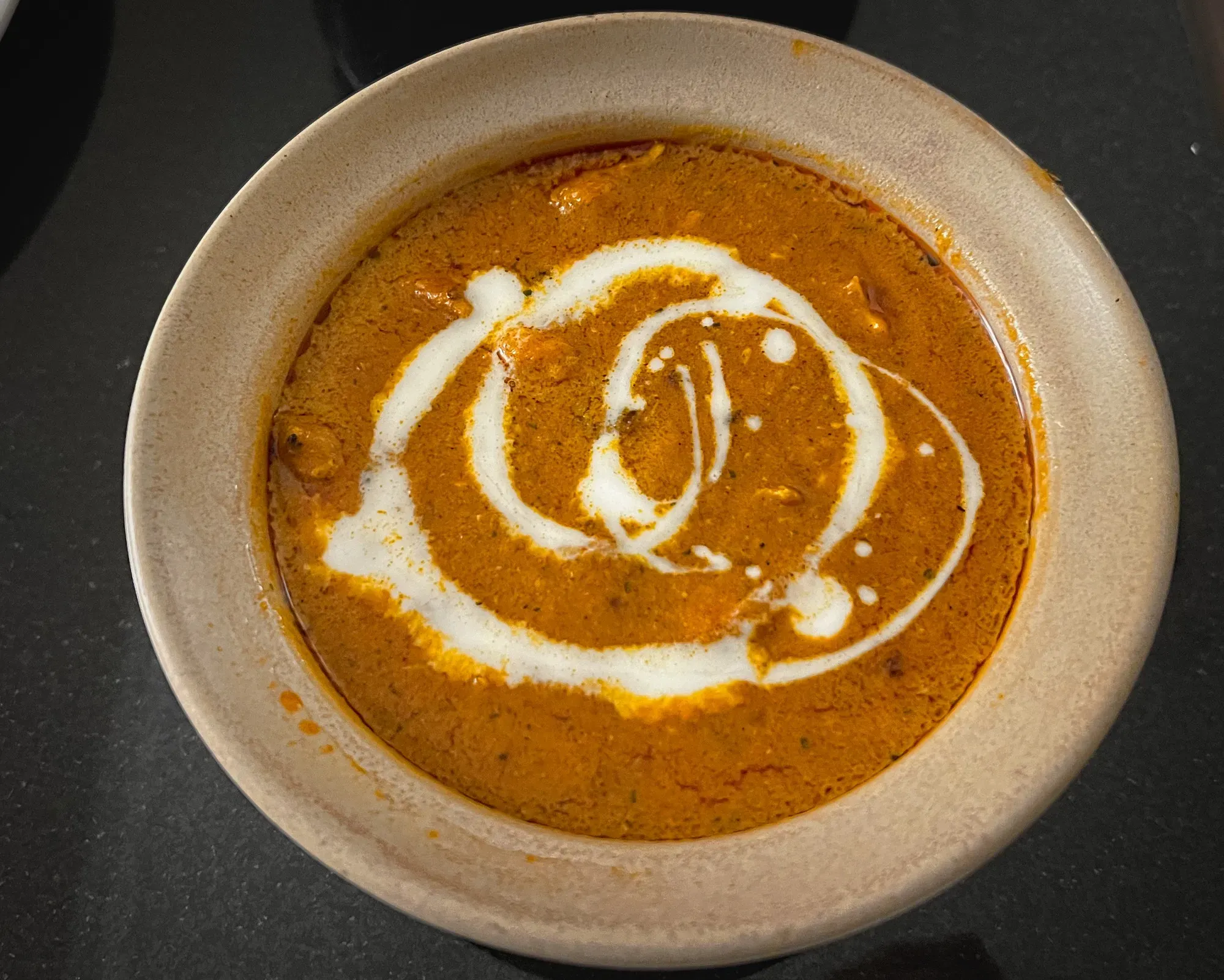
Butter Chicken along with Chicken Tikka Masala make up probably the most famous Indian dishes internationally. Its invention is most commonly attributed to a famous chef from New Delhi in the mid-20th century. The dish consists of marinated chicken in a creamy, tomato-based curry. The chicken is typically marinated in dahi (yogurt), Kashmiri chilies, garam masala, ginger paste, garlic paste, and lemon juice. The curry is made with tomatoes, a whole mess of spices (cardamom, cumin, cloves, cinnamon, coriander, pepper, garam masala, fenugreek, etc.), heavy cream, optionally cashew nuts, and of course, butter. It is a high-calorie, world favorite that makes for phenomenal comfort food.
Murgh (Chicken) Tikka Masala
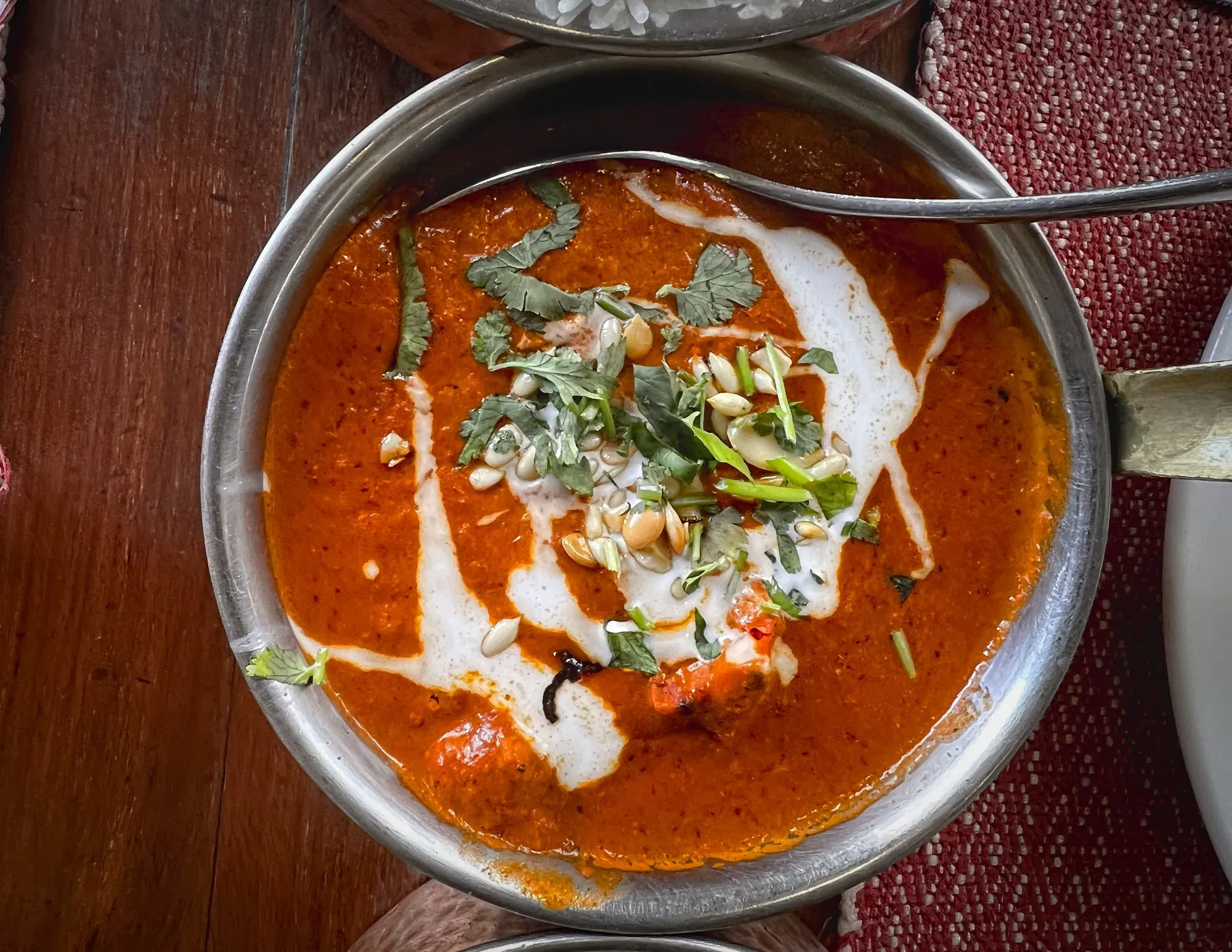
Chicken Tikka Masala is an extremely similar dish to Butter Chicken. In fact, the two are often equated even though they are not the same. Chicken Tikka Masala is always boneless (see Tikka below) and has a spicier, less creamy, more pronounced tomato flavor to its curry.
Palak Paneer
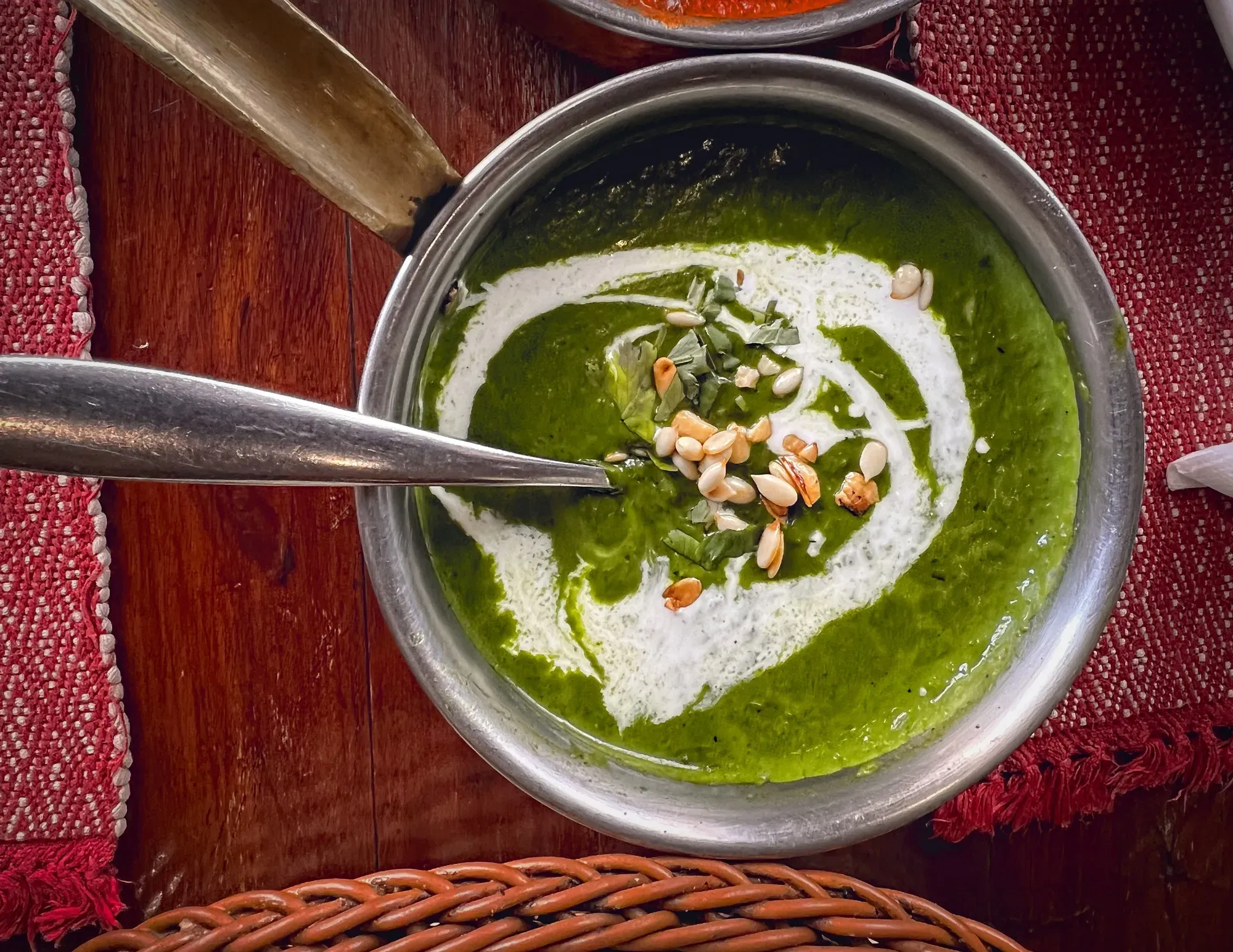
Palak refers to a thick curry paste from pureed spinach. Palak curries are made by pureeing spinach, adding sautéed tomatoes and onions, and then spiced with typical Indian spices (garam masala, chili powder, cumin, ginger, garlic, more tomatoes, and turmeric). Paneer is Indian cheese: specifically, it is a non-aged, non-melting soft cheese made by curdling milk with an acid. Palak dishes can be done with a variety of protein sources, Palak Paneer is simply the most popular variation.
Saag (Saagwala)
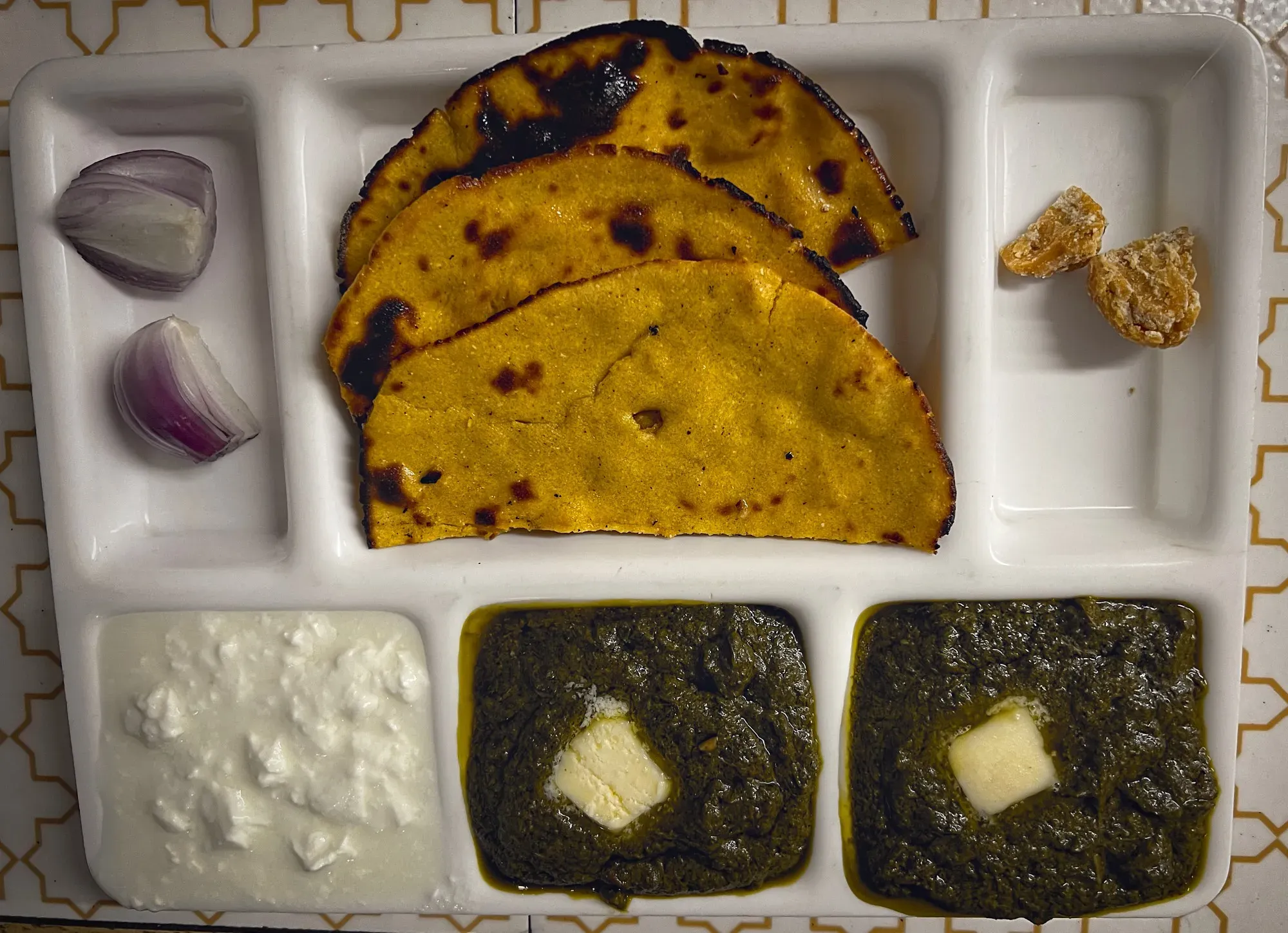
Saag is an extremely similar dish to Palak, again, often being used interchangeably internationally. Although similarly, they are not the same dish. While Palak is only pureed spinach, Saag includes other green leafy vegetables like mustard greens, collard greens, radish greens, fenugreek leaves, and others. In the winter, Saag becomes very popular as a seasonal dish in the north, and is served with Makke Ki Roti: it is delicious!
Rogan Josh (Roghan Ghosht)
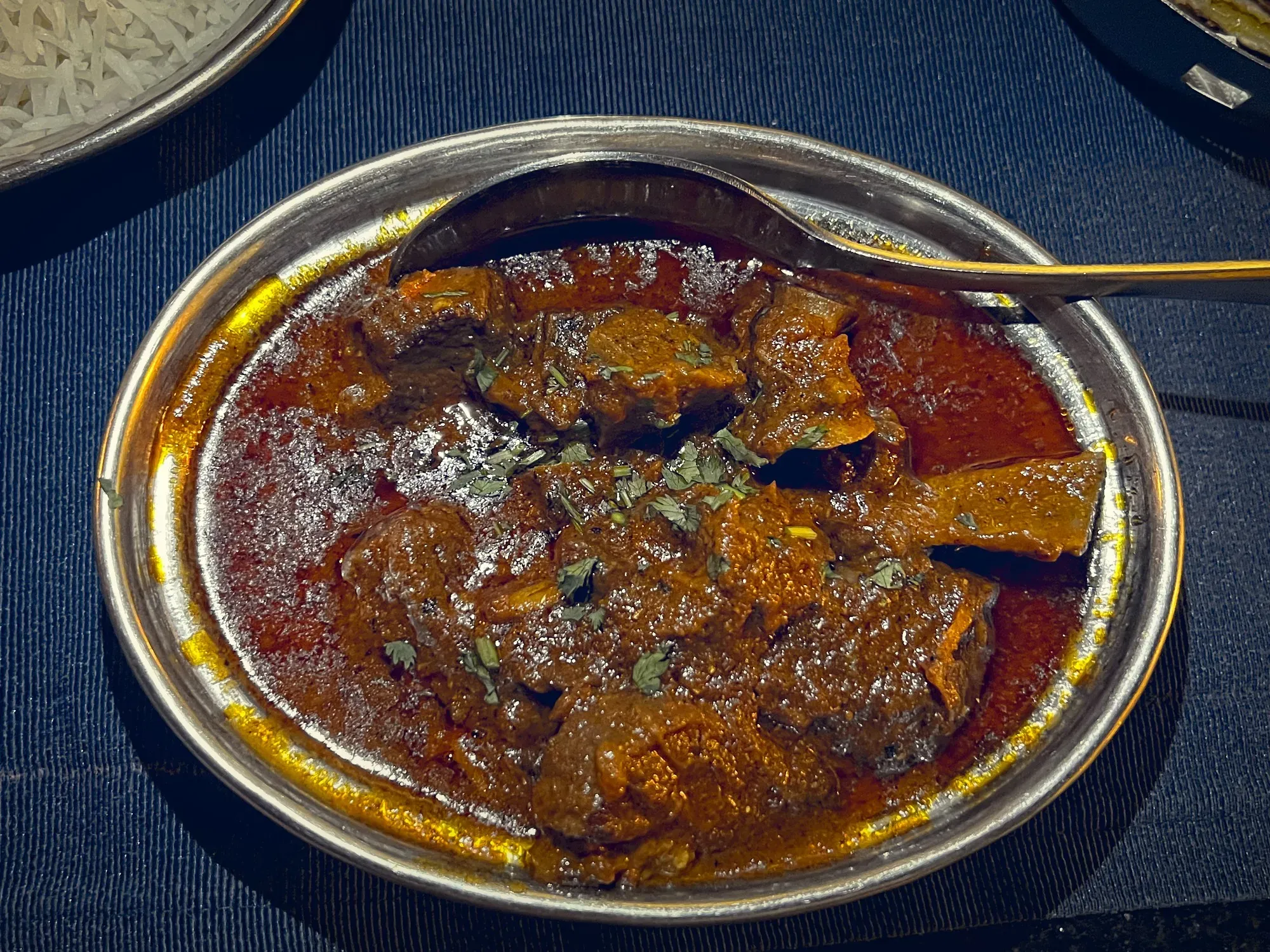
Rogan Josh is an aromatic mutton/lamb/goat dish from Kashmir. It is a deeply flavorful meat curry that emphasizes aroma rather than heat. A traditional dish uses a characteristic alkanet flower/root and Kashmiri chilies to give the dish its unique aroma as well as a deep red color (a combination of paprika and cayenne pepper are frequently used as alternatives). The curry is slow cooked with garlic, ginger, cloves, bay leaves, cardamom, cinnamon, onions, yogurt, and sometimes saffron. The slow cooking process (also called Dum pukht, or just Dum) produces a beautifully tender and aromatic dish that is one of our personal favorite all-time dishes.
Dal Makhani
Dal Makhani is a popular North Indian lentil dish made with a smokey, buttery curry. The dish is made with black lentils (urud dal), onion, ginger, garlic, tomato puree, garam masala, chili powder, and cooked with tons of butter and cream. Sometimes rajma (kidney beans) are added as well. To give it a strong smokey flavor, the curry is infused with a charcoal flavor using what is called the “dhungar method”. Dhungar involves adding a smoking charcoal (in a bowl, not direct contact) and sealing it with the food to infuse a smokey flavor over a period of time. The end result is a smokey, extremely buttery lentil dish which is high-calorie deliciousness.
Dal Tadka (Tadkewali Dal)
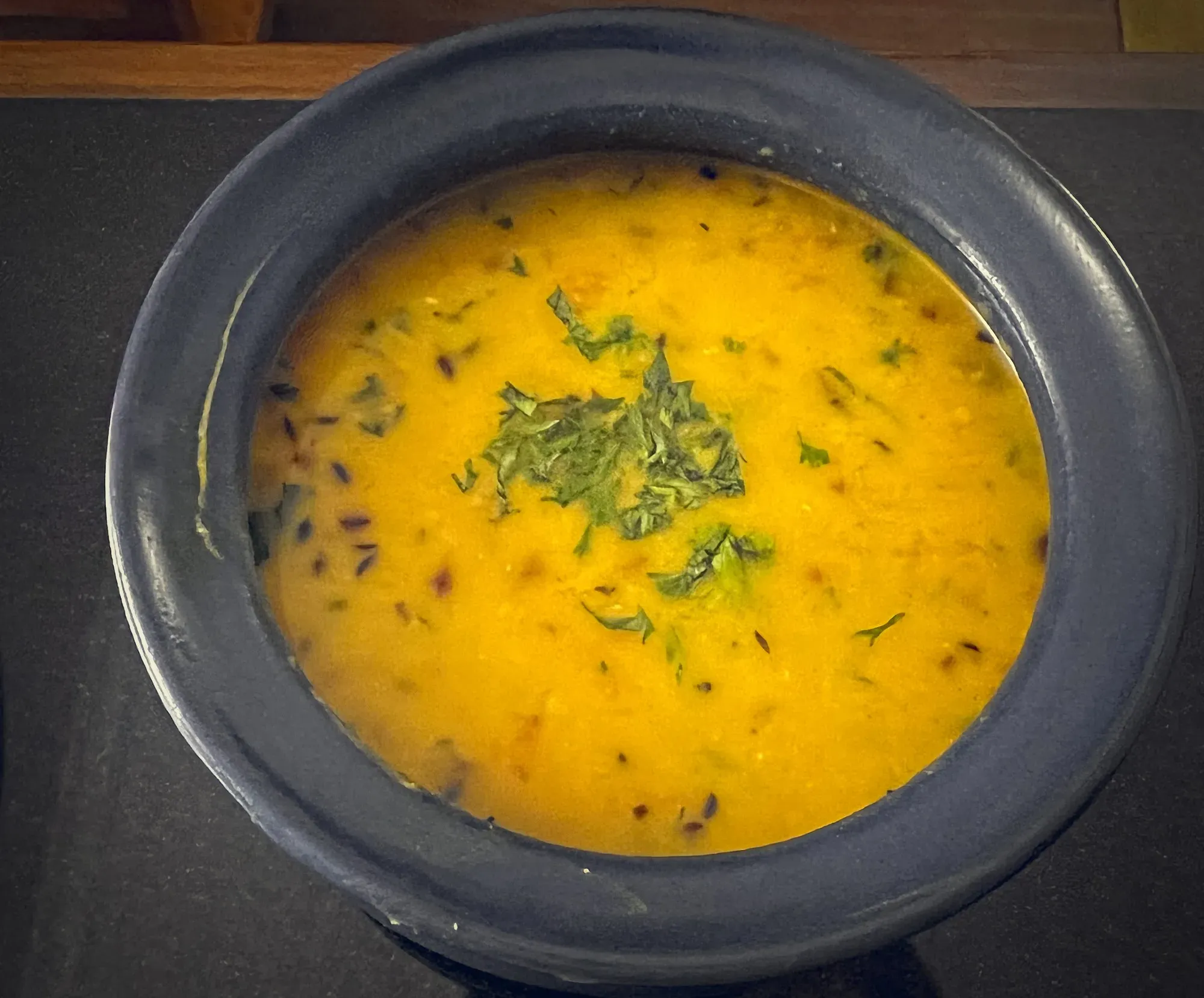
Dal Tadka is a simple North Indian lentil dish that is “tempered” with spices and ghee/butter. Spices (cumin, coriander, mustard, garlic, ginger, chilies, chili powder, garam masala, turmeric fenugreek, etc.) are first fried in ghee, then turmeric-infused lentils (most commonly toor dal, or pigeon pea lentils) are added until everything is fully cooked. Optionally, the Dhungar method can be used to impart an extra smokey flavor to the dish.
Tandoori
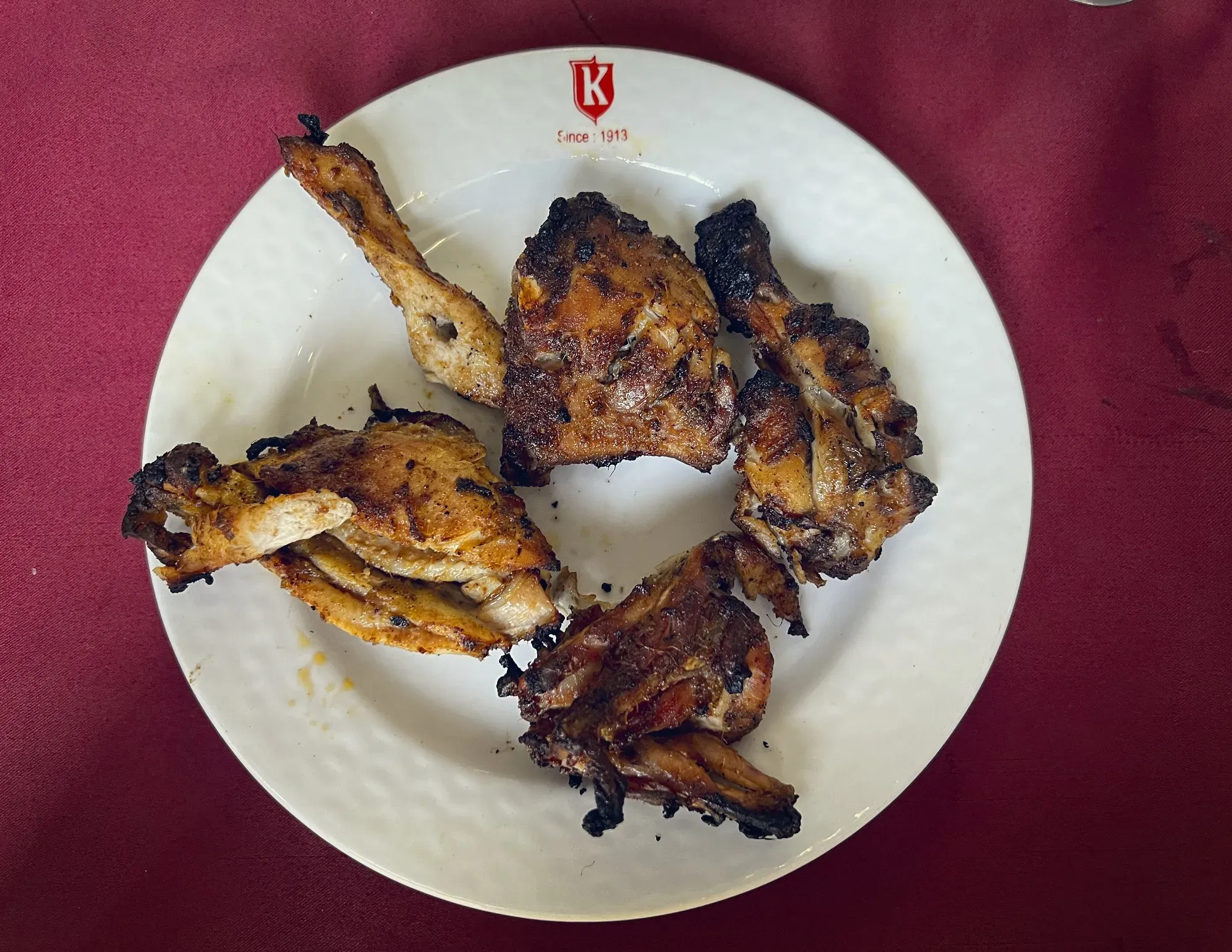
Tandoori refers to a style of cooking in which a protein is marinated in yogurt and spices (garam masala, garlic, ginger, onion, cayenne pepper, etc.), and then roasted in a tandoor, or a cylindrical clay oven. The most popular variation is with chicken, although practically anything can be cooked Tandoori style.
Tikka
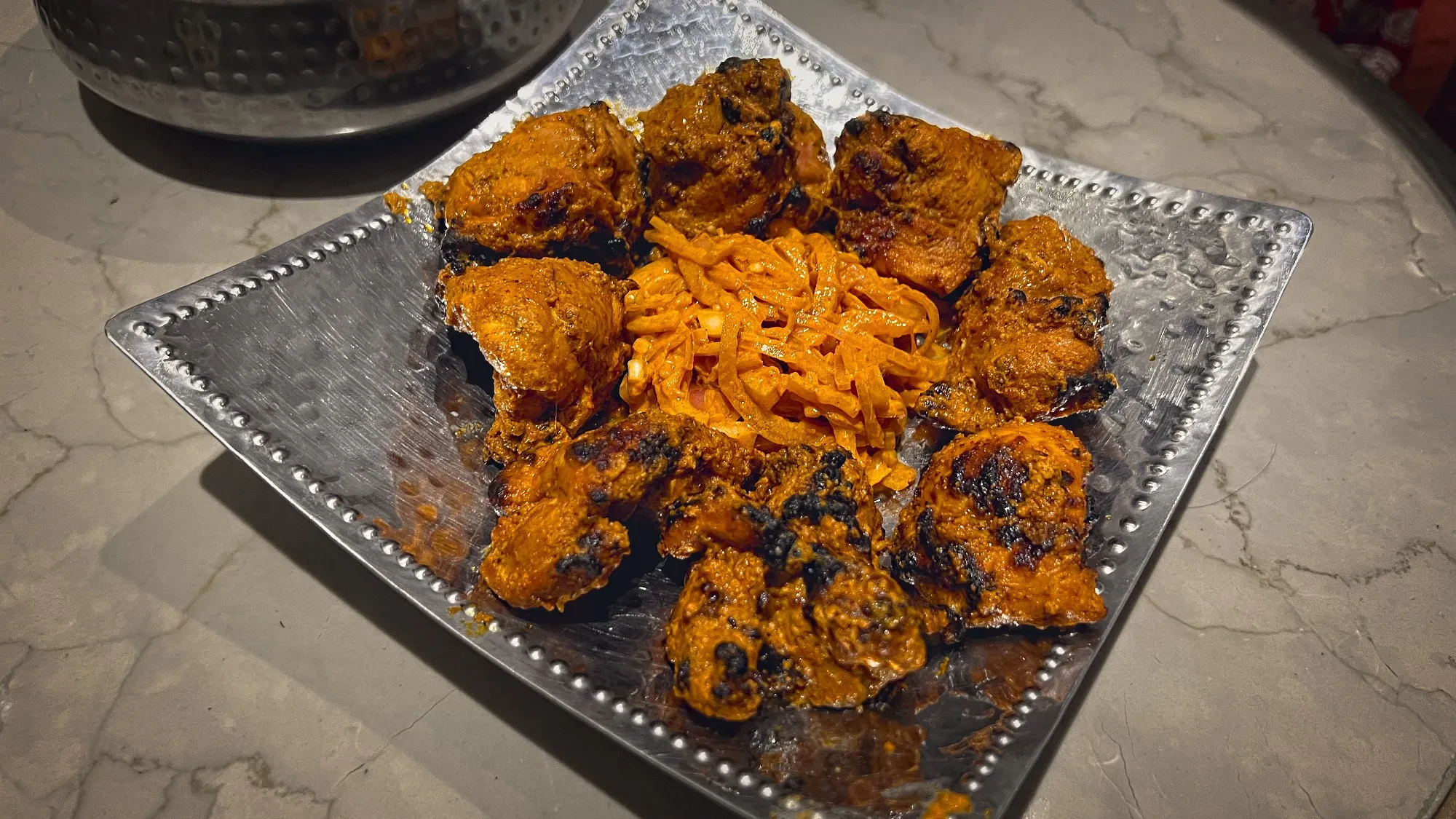
Tikka refers specifically to boneless meat that is cooked in a tandoor or grilled. There is certainly some overlap with Tikka and Tandoori as the marinades are similar, but Tikka is used as shorthand for specifically boneless meat that is marinated and cooked.
Biryani
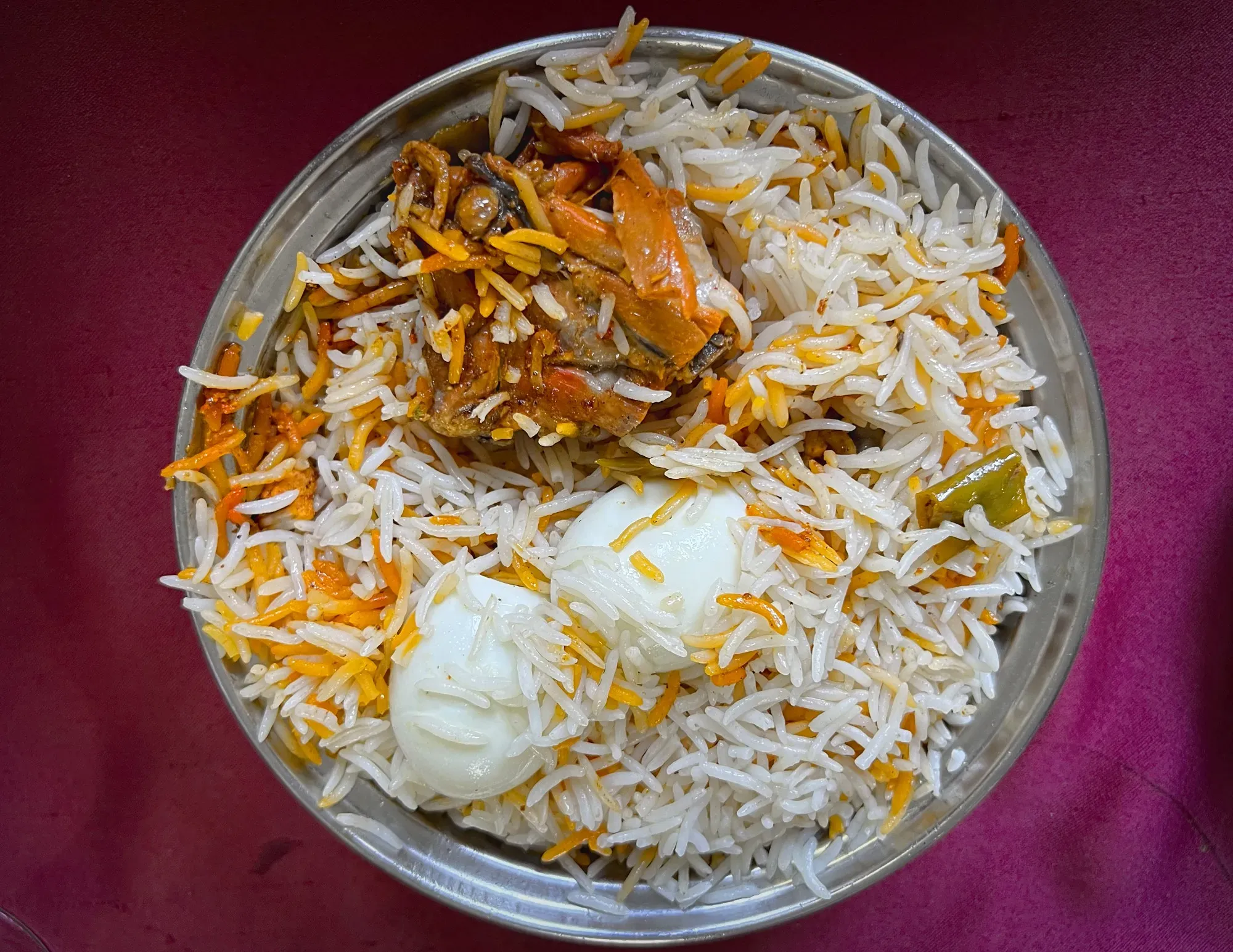
Biryani is a mixed rice dish of rice, a meat, and Indian spices. It is a fairly simple dish, yet is one of the most popular dishes in all of South Asia. The formula for Biryani is simple, but from it one can concoct a vast variety of dishes. There are so many regional variations to Biryani it is nearly impossible to count them all. One of the most famous variations is Hyderabadi biryani in which the raw rice and meats are cooked together with the dum method (slow-cooked).
Secondly, not only can biryani take lots of different regional variations, but it also can go by a few names. Many people use these names to differentiate this family of dishes based on cooking technique. Typically, biryani is made using the "draining method", but a regional technique like the famous Hyderbadi biryani would use the dum method. Pulao, on the other hand, is another rice and meat dish that uses the "absorption method". This naming convention is not perfectly followed though, and some places will use pulao interchangably with biryani. It all depends, as is the wonderful complexity of life.
Chutneys
Chutneys are Indian dips / spreads that accompany or top a plethora of Indian cuisine. They encompass a massive range of flavors, from tomato relish to chili onion to mint yogurt.
Chaat
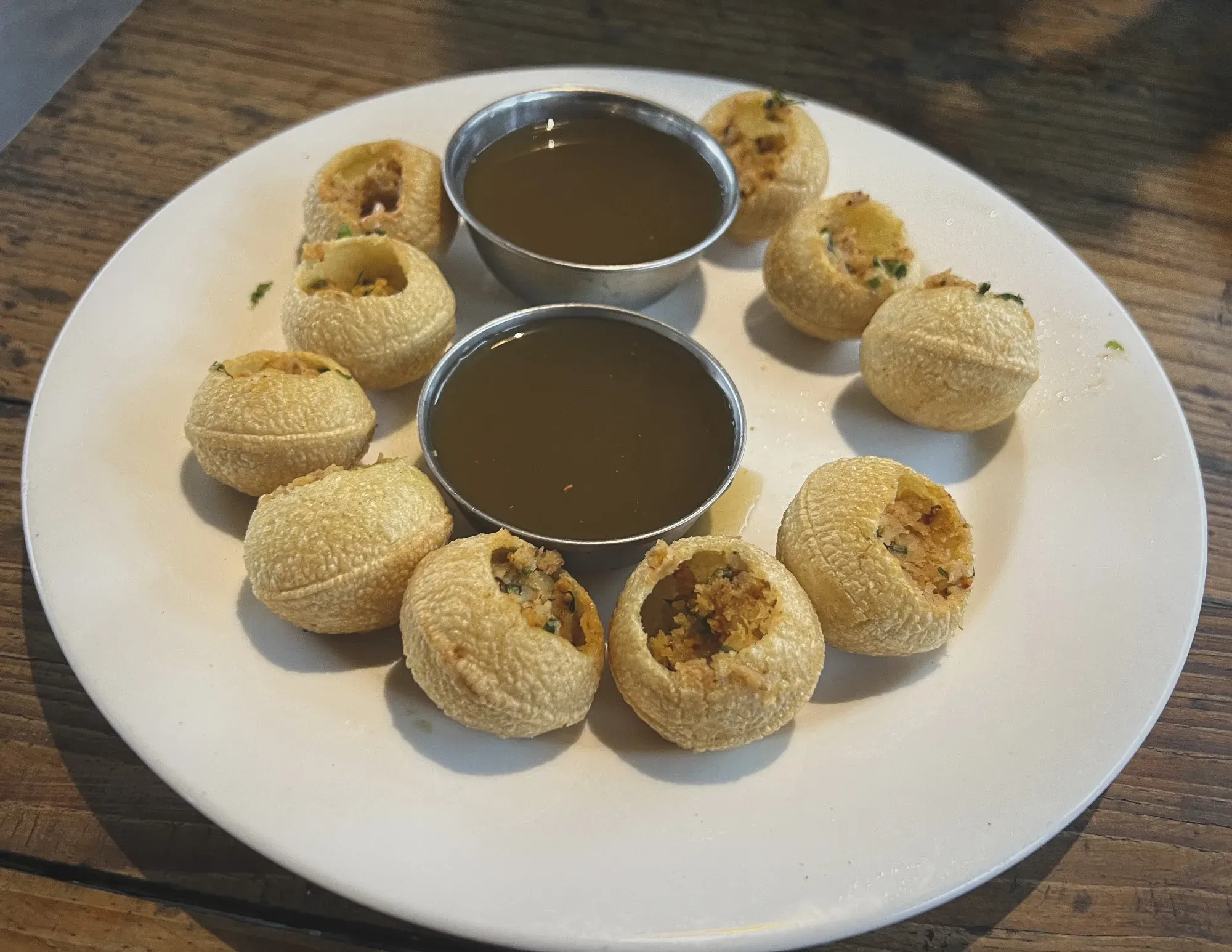
Chaat refers to a broad family of savory Indian snacks. Chaat encompasses a category that combines different flavors, textures, and spices together to create a unique and tasty experience. While originating in North India, Chaat has now morphed into a massive class of foods that are immensely popular all over India and the rest of South Asia. Chaat variants are all based on a fried dough with a tangy-salty blend of complementary ingredients. Pani Puri is one of the most popular chaat options you will find.
Samosa
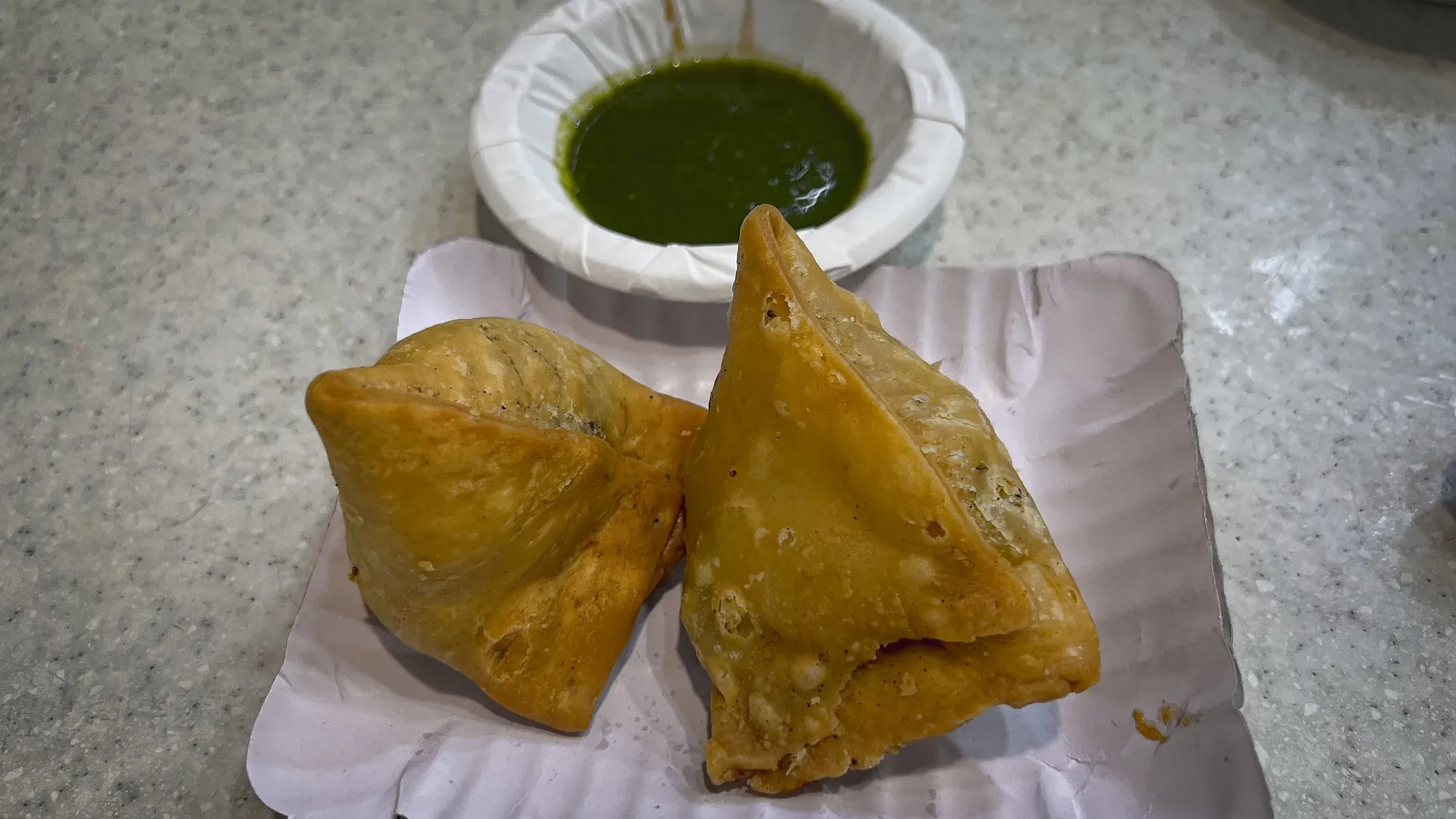
Samosa is a fried pastry with savory ingredients: most commonly spiced potato, onions, and peas. They can take many shapes based on the region/style, the most famous being a triangular pyramid. They are an extremely popular appetizer, and are usually accompanied by chutneys. The origin of Samosa is the Middle East, but are now an integral part of the North Indian cuisine as well.
Lassi
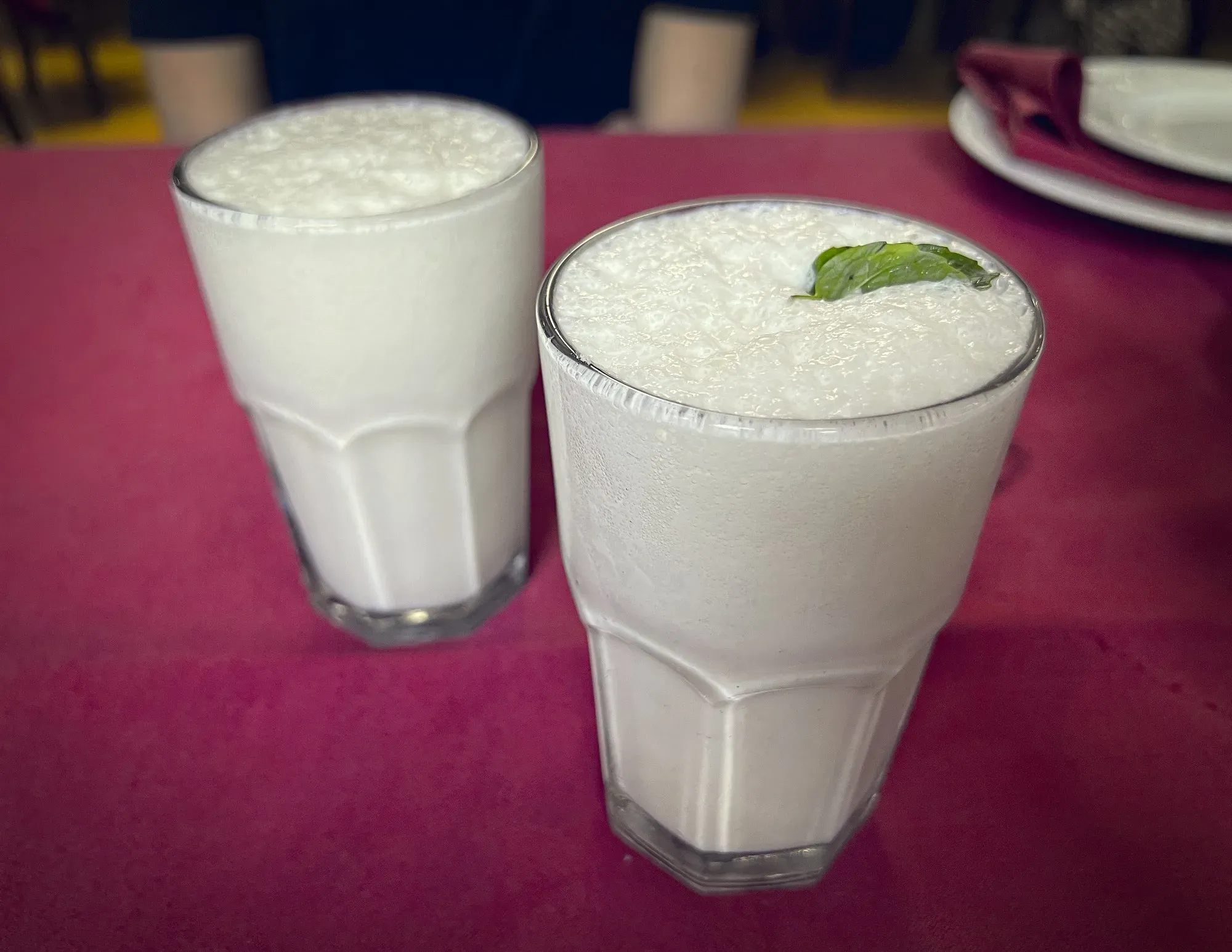
Lassi is a yogurt-based drink popular in India. Lassi can be salty, sweet, or infused with fruit. Plain, sweet Lassi are most popular in India, while Mango Lassi are most popular in international restaurants.
Raita
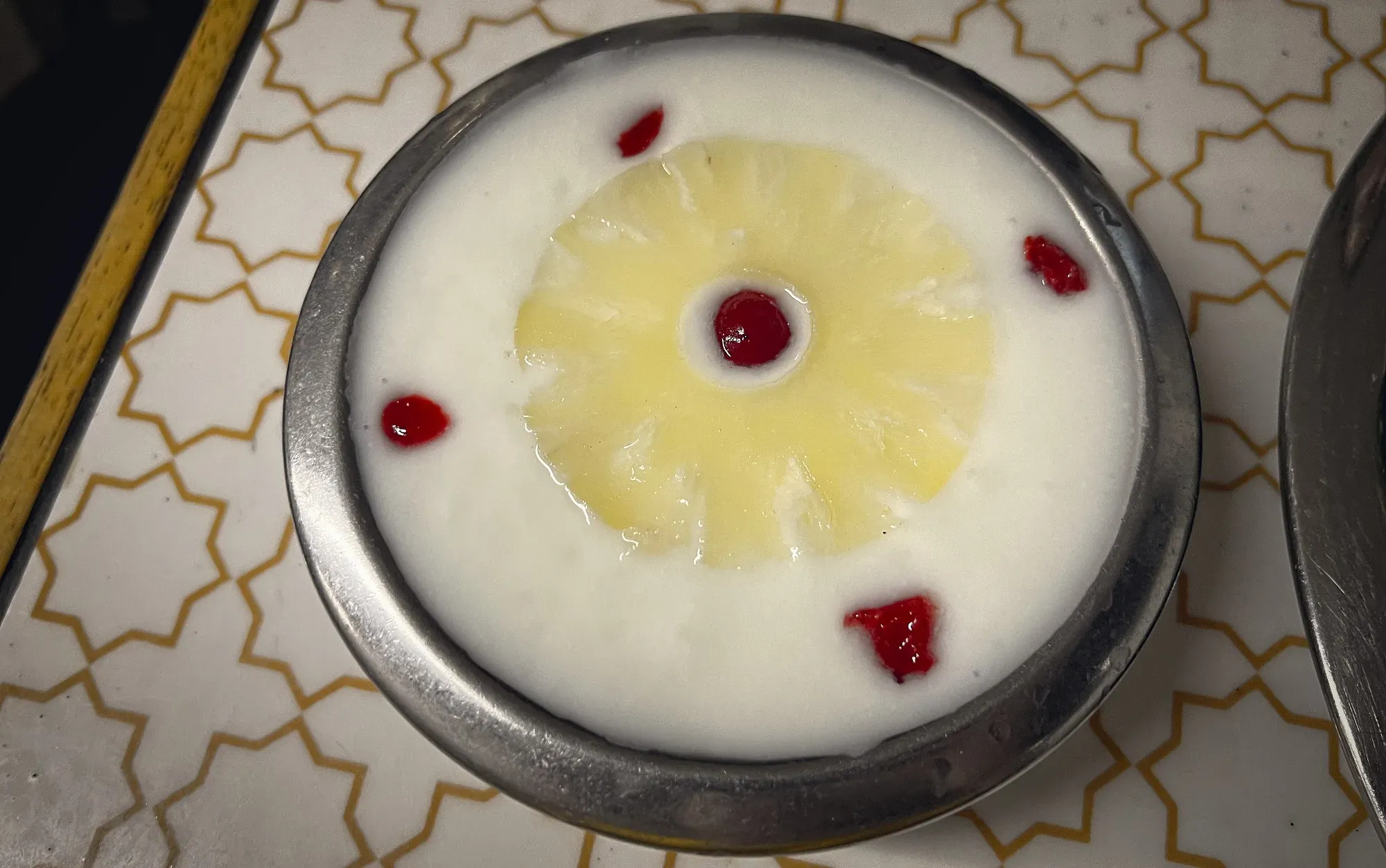
Raita is a dip / condiment made by combining yogurt with vegetables, fruit, or drops of chickpea flour (boondi raita). The most popular versions are onion, mixed, pineapple, mint, or boondi. It is served as a side dish with spicy curries and meats to cool down the heat. It is a wonderful little saving grace for those who can not handle the heat of some of the hottest Indian dishes, but still want to order them for their intense flavors.
Gulab Jamun
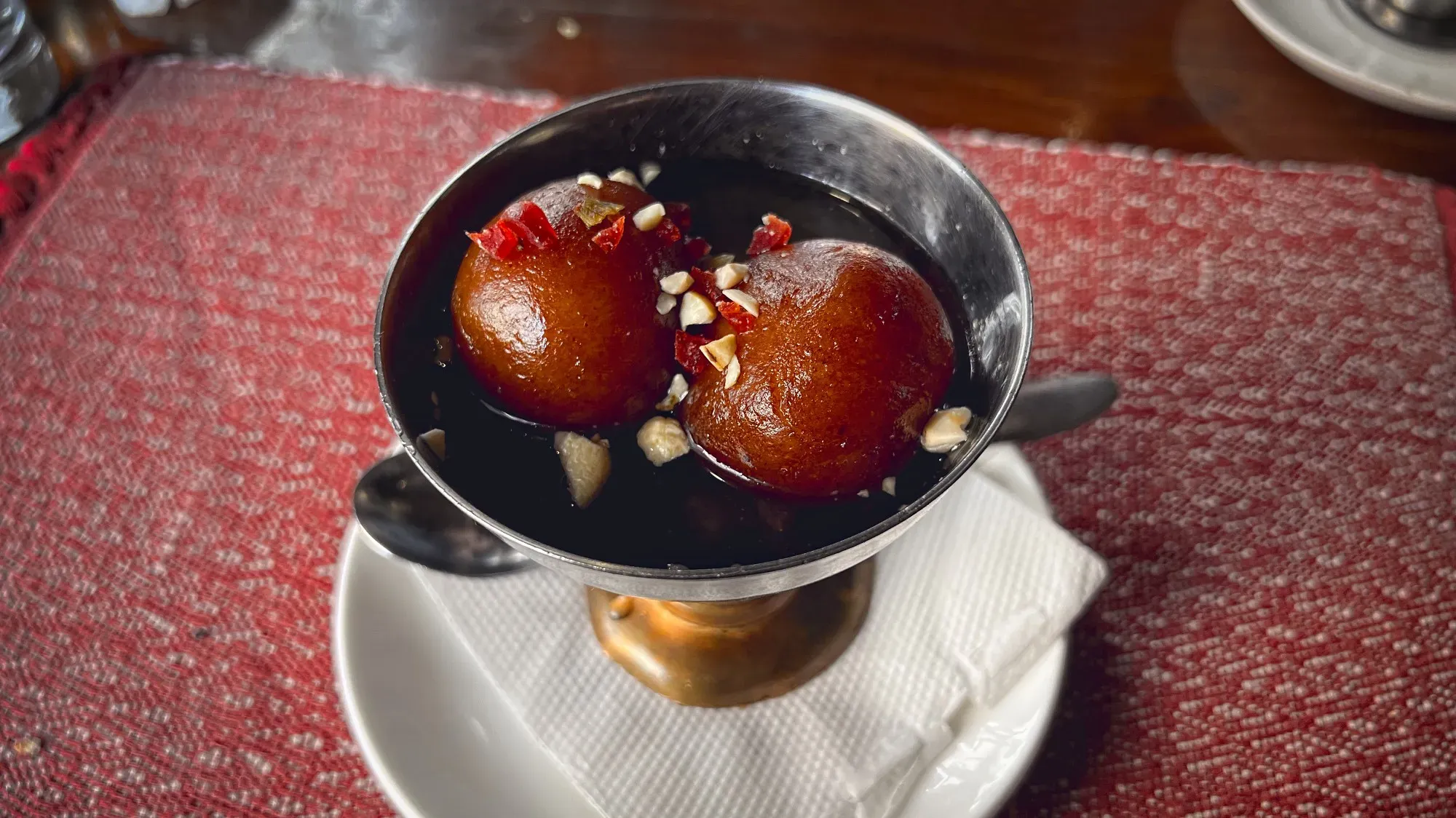
Gulab Jamun is an incredibly popular Indian dessert featuring milk solid balls soaking in syrup. The deep-fried balls of dough are soaked in a sugar syrup flavored with cardamom, rose water, and saffron. The dough is made from a mix of khoya (reduced milk solids), flour, and semolina, which is then rolled into small balls and deep-fried until golden brown. These fried balls are then soaked in the sugar syrup, which gives them their distinctive soft and spongy texture. They are an extremely sweet confectionary treat that are often garnished with nuts or served with Kulfi (Indian ice-cream).
Kheer / Payasum
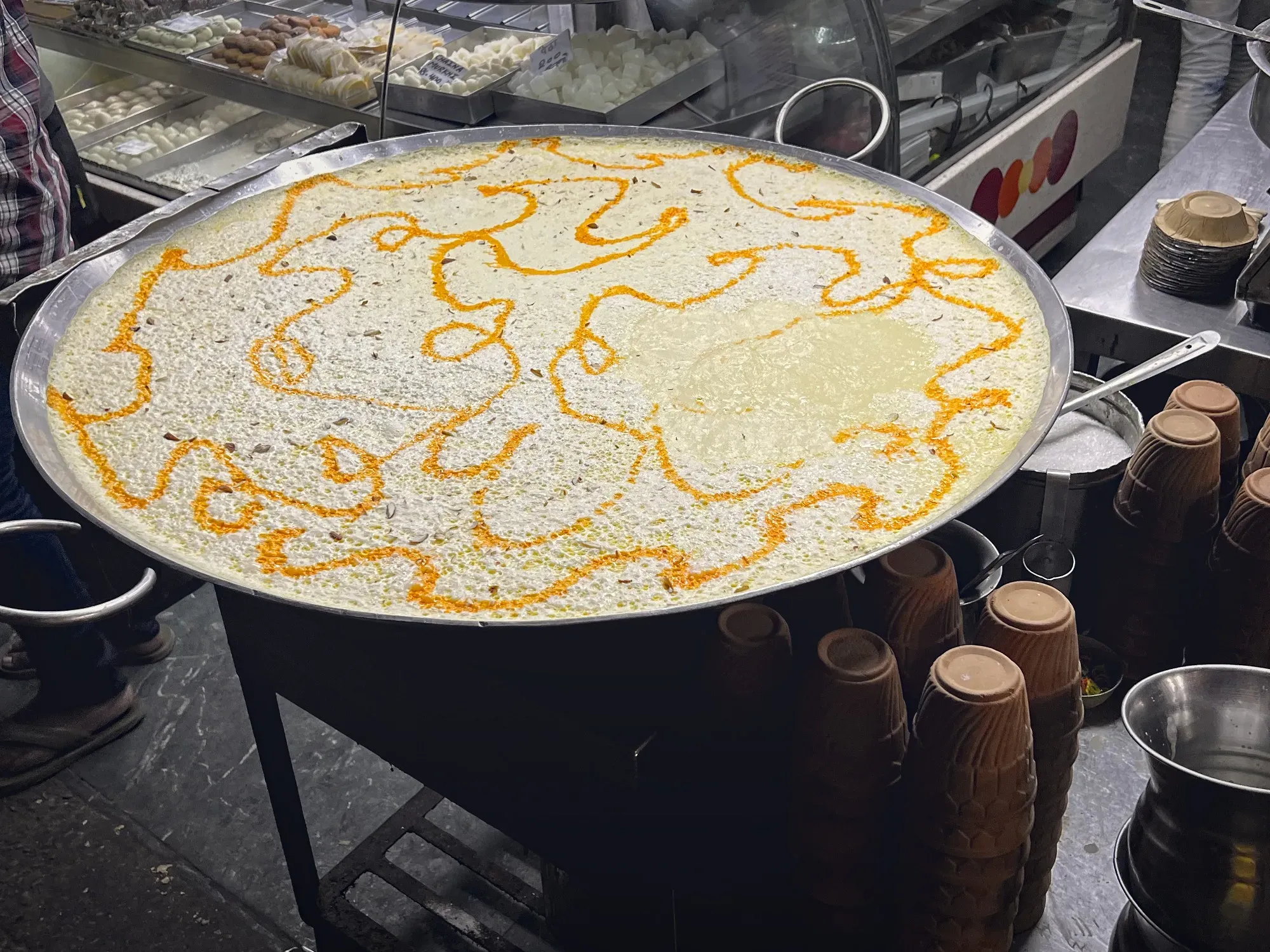
Kheer, also known as Payasam is Southern India, is a popular Indian dessert that is made by boiling rice, vermicelli, or broken wheat with milk and sugar. This dessert is typically flavored with cardamom, saffron, or other spices, and can be garnished with nuts and dried fruits.
The origin of Kheer dates back to ancient India and is mentioned in various Sanskrit texts. It is believed to have been a popular dish in royal courts, served as a sweet treat during feasts and celebrations.
Today, Kheer is enjoyed across India, and many regional variations exist. In the southern state of Kerala, it is made with coconut milk and jaggery, while in North India, it is often made with basmati rice, condensed milk, and almonds.
Kheer is typically served as a dessert after a meal, but it is also sometimes offered as a sweet dish during festivals and special occasions. It is known for its creamy texture and sweet flavor and is a favorite among those with a sweet tooth.
Naan
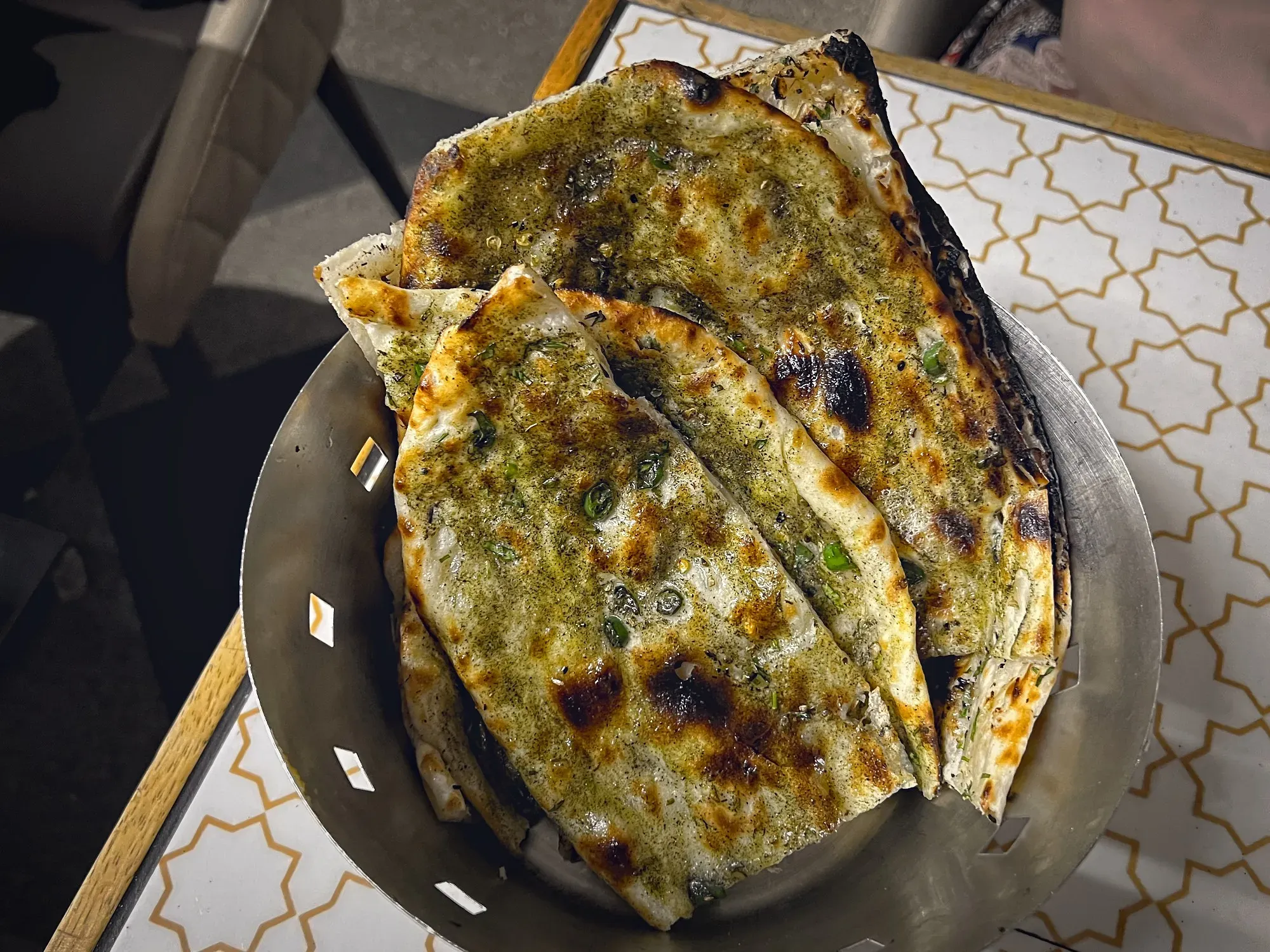
Naan is the most popular Indian bread internationally. It is a bit harder to make, but is beloved by the world as a pairing with all North Indian curries. Naan is a leavened bread made with yeast and maida, a white flour from wheat, closely resembling cake flour. It can be made in a variety of styles, but Garlic Naan is by far the most popular.
Roti / Chapati / Phulka
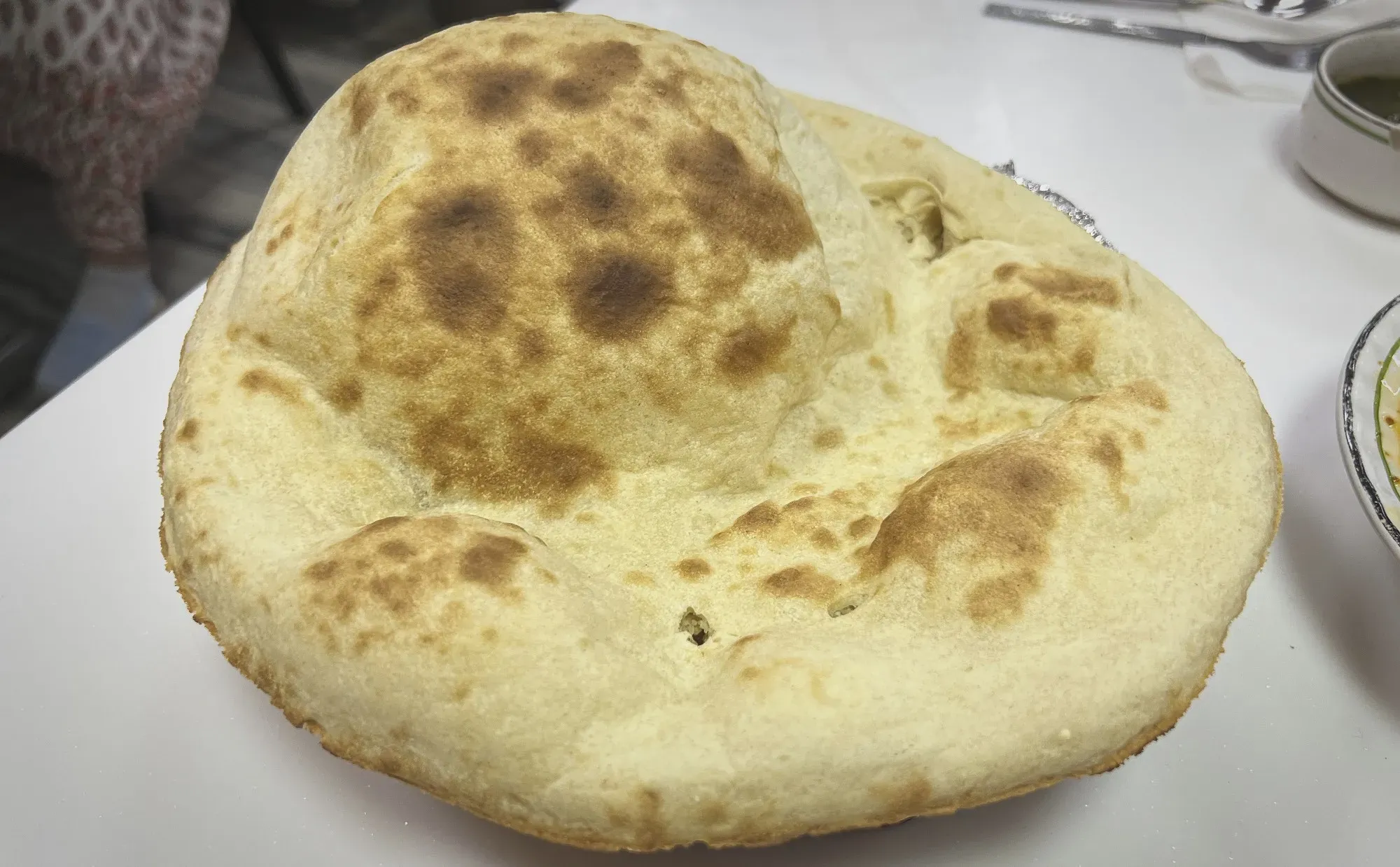
Roti, Chapati, and Phulka refer to the same thing, an unleavened flat-bread made with wheat flour. Everyone has their own slightly different style of the dish, and it is the most popularly baked bread in an average Indian household. Round and soft, the Roti goes well with practically any Indian dish.
Paratha
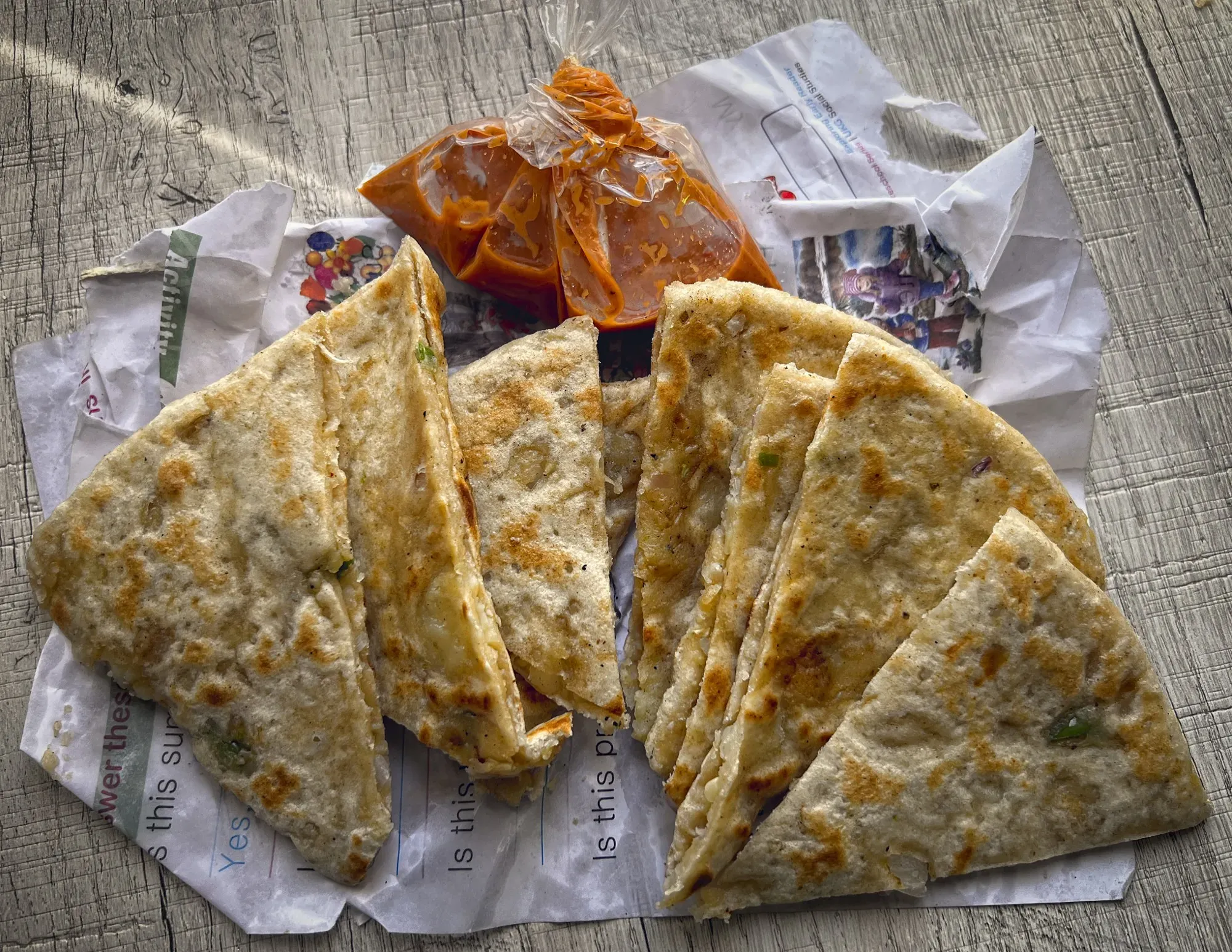
Paratha are another variation of unleavened flat-bread made with wheat flour. Paratha can be made plain, mixed, or stuffed. Mixed paratha are prepared by combining the dough with ingredients like coconut, sattu (chickpea flour), laccha (a layered preparation style, not an actual ingredient), garlic, or methi (fenugreek leaves). Stuffed paratha can be filledwith practically anything. Some popular examples include: aloo (potato), paneer, cheese, cauliflower, mixed vegetables, spinach, onion, lentils, or kheema (minced meat).
Regional-Specific Shoutouts
Kulcha
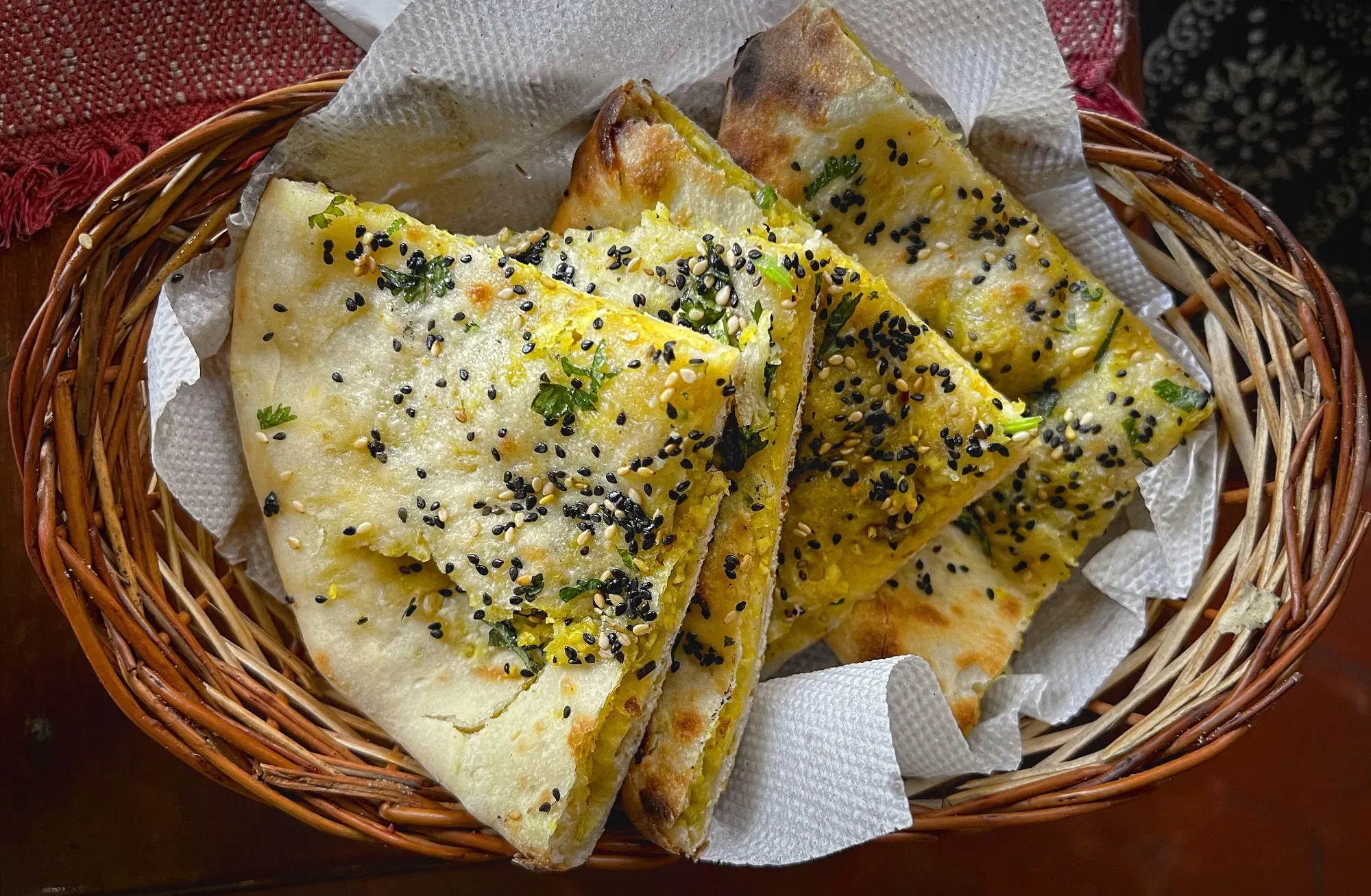
Kulcha is a leavened bread from Northern India made with yeast and maida, a white flour from wheat, closely resembling cake flour. Kulcha dough is mixed together to form a tight dough, and only allowed to rise for a short period to form partially leavened dough. It is similar to Naan, but the partial leavening gives it a distinct taste. Amristar Kulcha, named after the probably birthplace of Kulcha, is one of the multiple names given to stuffed kulcha, the most common type which marks another subtle difference between naan and kulcha. It also happens to be a heavenly invention, and cannot be missed.
Puri (Poori)
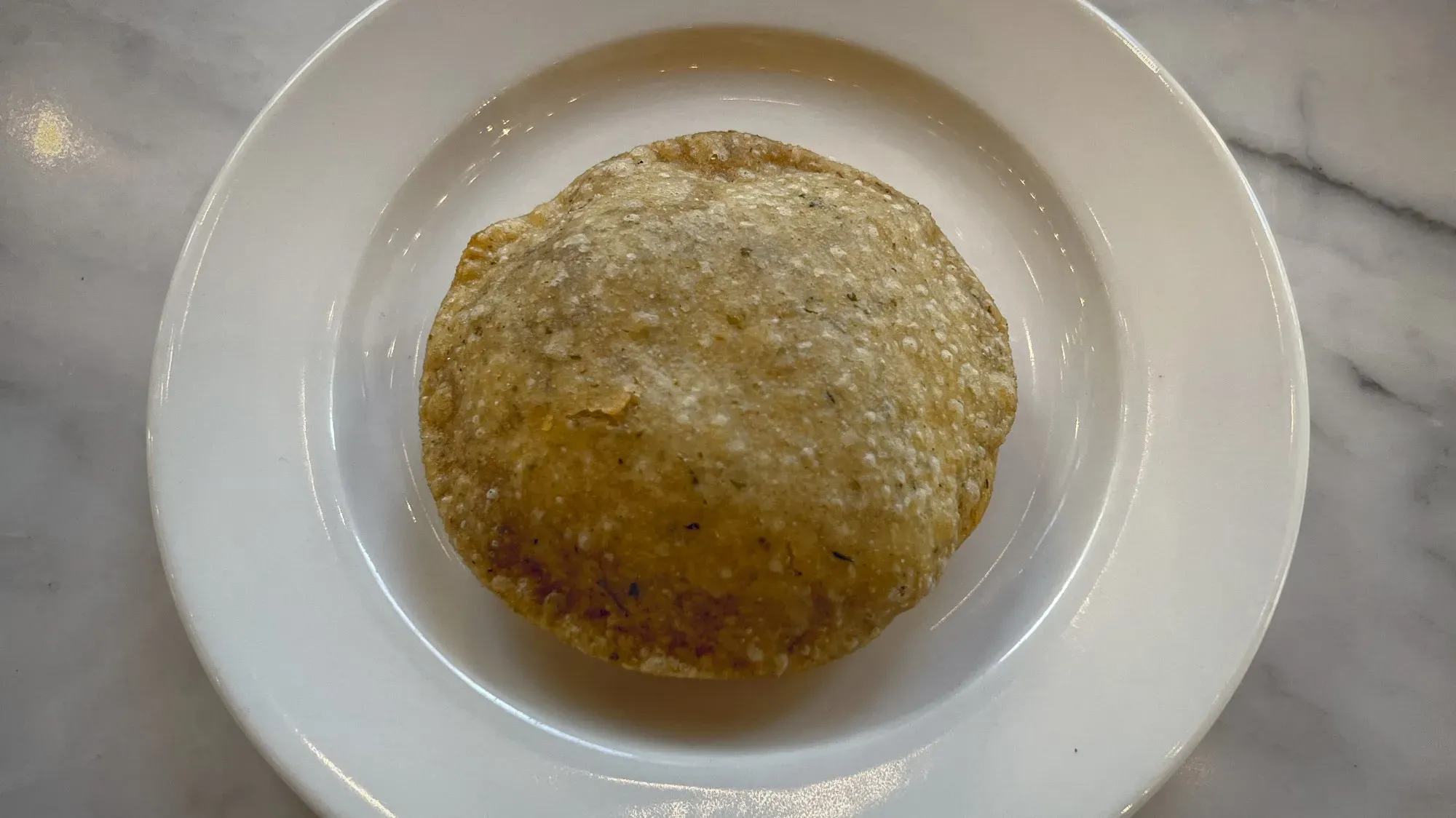
Puri is an unleavened, fried flat-bread made with wheat flour. Once fried, it puffs up into a small, hollow ball of doughy goodness. It is closely associated with festivals and ceremonial events in India.
Papad (Pappadam)
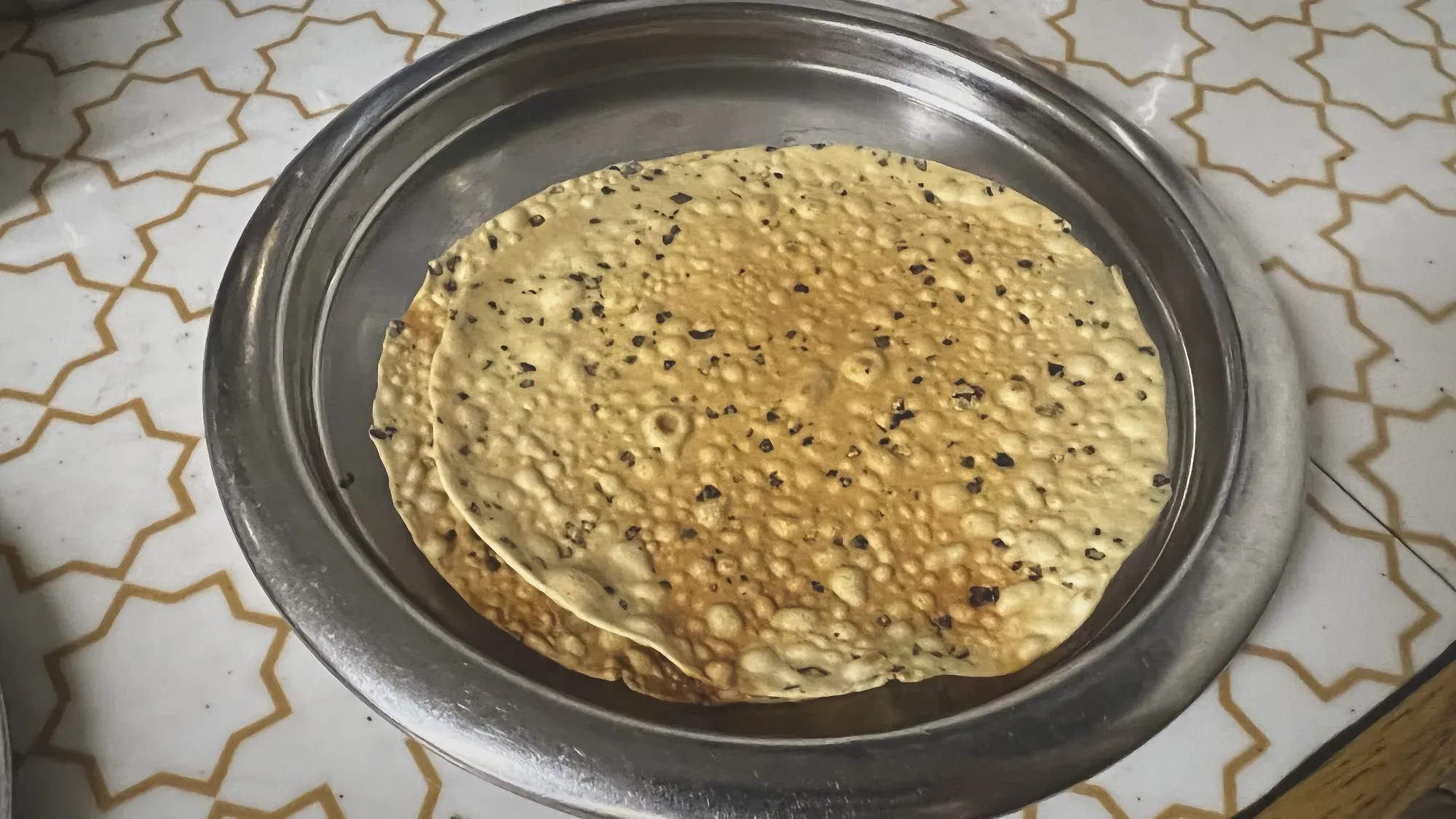
Papad is a deep fried flat-bread that is cooked until crunchy. They are made with either lentils, chickpeas, black gram, rice, or potatoes depending on the region. Salt and peanut oil are added to the dough which are flattened into thin disks, and are seasoned plentifully with black pepper as well as other optional spices. They are commonly served as an accompaniment to a meal, but can also be served as an appetizer with chutneys.
Chole Bhature
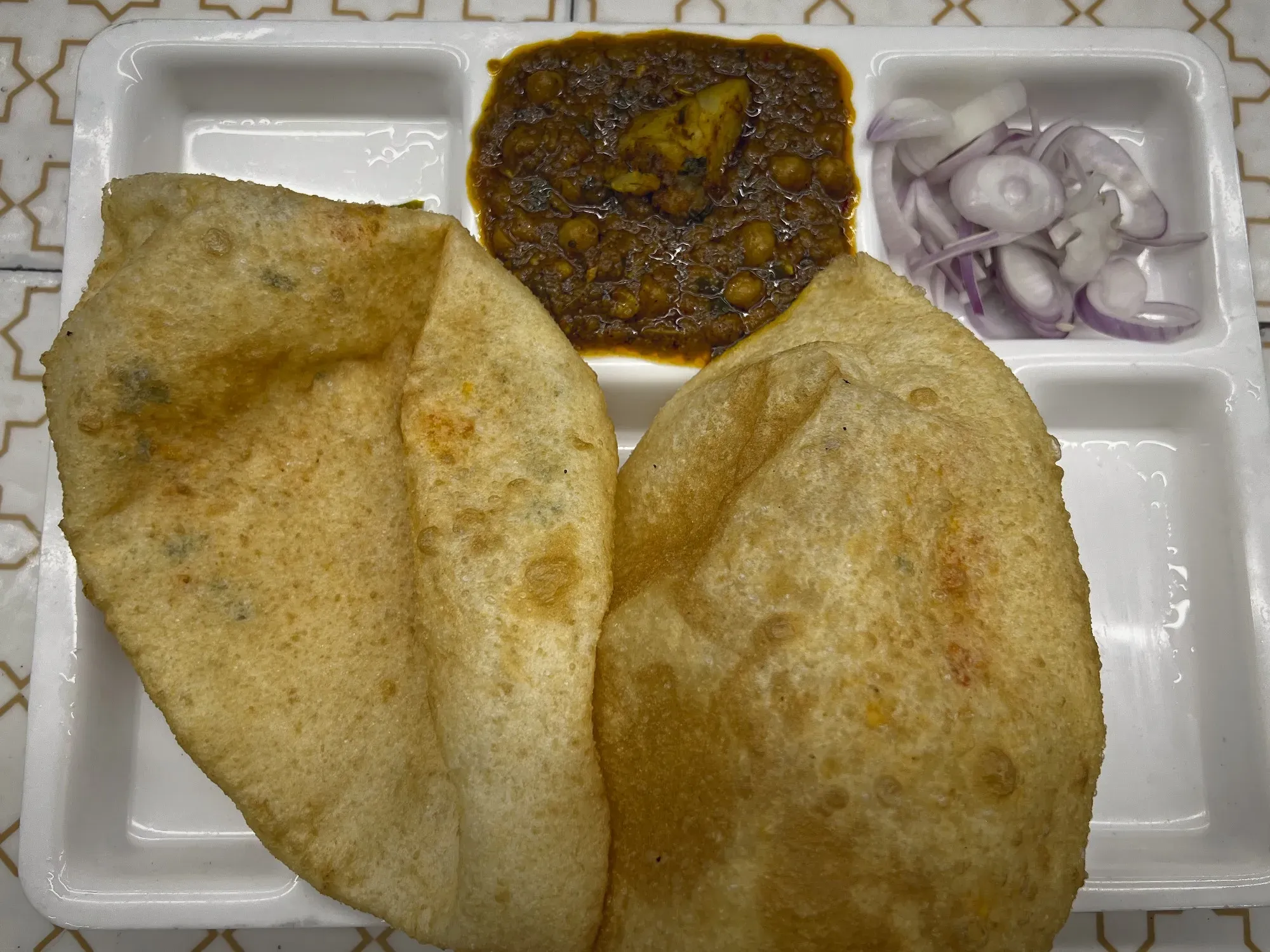
Chole means “chickpea” and Bhature is a type of Indian bread that is basically a massive puri. The chickpeas are slow-cooked in a tomato-based gravy with a blend of aromatic spices such as cumin, coriander, and garam masala. The bhature is made from a dough of all-purpose flour, yogurt, and spices, which is then deep-fried until golden and crispy. This dish is a popular Punjabi breakfast or lunch which pairs the fluffy fried bread with a chickpea curry.
Dal Baati [Churma]
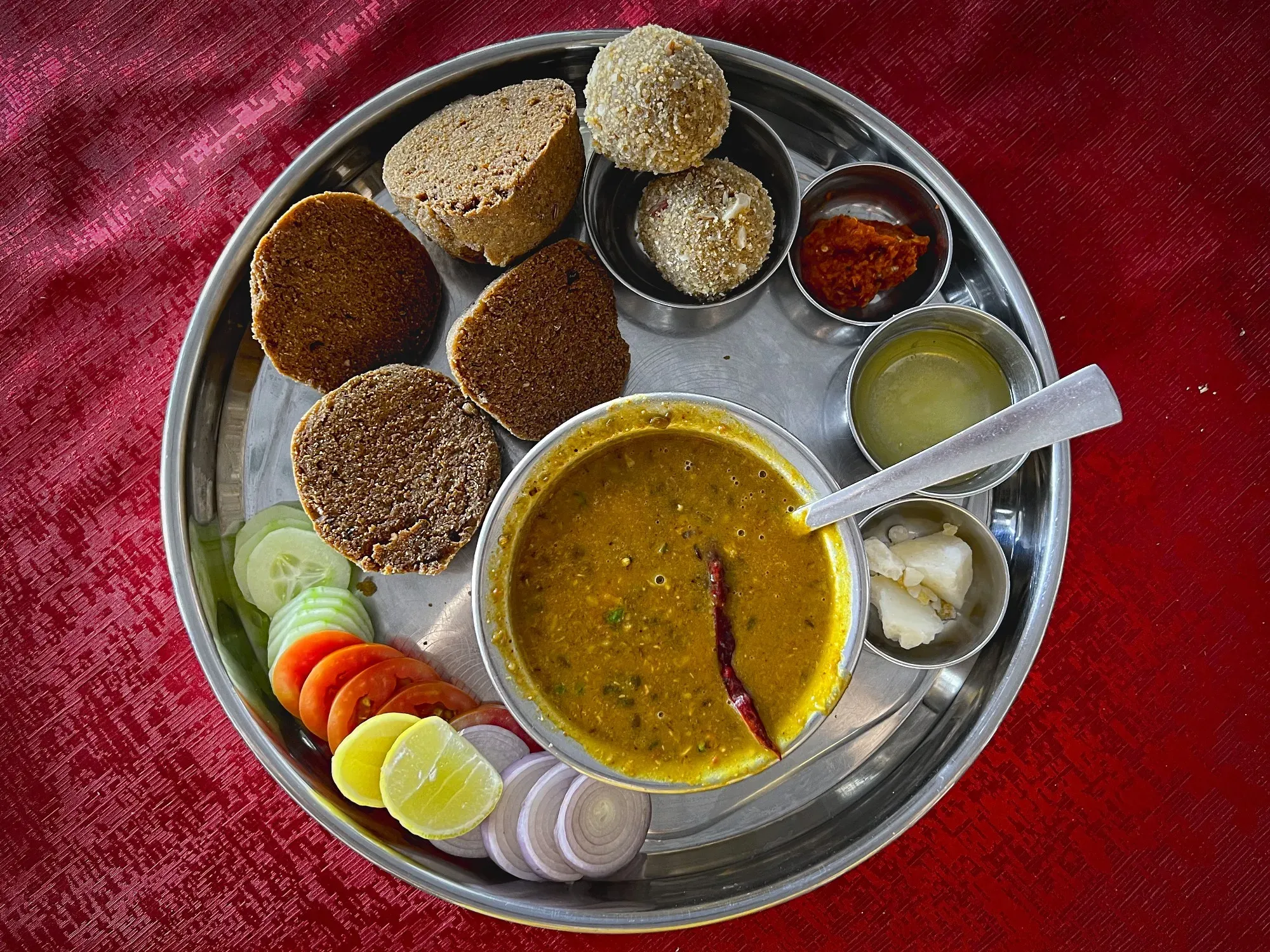
Dal means “lentils” and Baati are fried or baked dough dumplings of wheat and semolina. Like many Indian foods, Baati can be made of a variety flour types and be mixed or even stuffed with other ingredients as well. This dish is a popular Rajasthan speciality that combines a spicy lentil curry with the baati to create a scrumptious, spicy platter. Additionally, this dish is often served as Dal Baati Churma, which adds a sweet contrast to the meal in the form of a churma. Churma is a generic term that encompasses a wide variety of things that is best summarized as “sweet stuff made of whole wheat and semolina”.
Shahi Paneer (Royal Paneer)
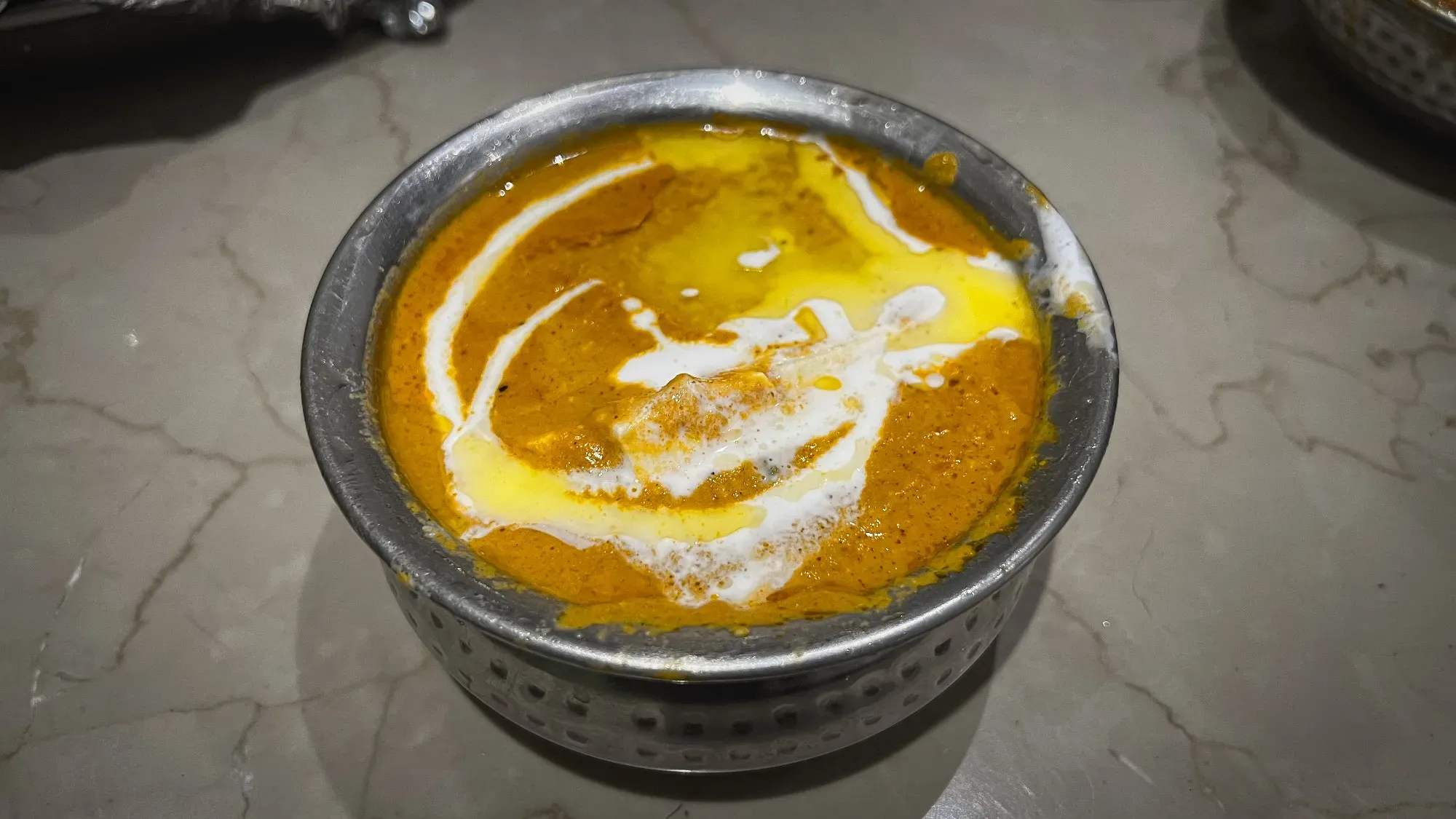
Shahi paneer is a famous, creamy curry from North Indian royal cuisine. Shahi is a reference to the royal title "Shahanshah" and speaks to the fact that this dish originated from Mughal royals kitchens as a decadent dish. It is prepared by emulsifying tomatoes, onions, cashews, spices, butter, and cream into a curry with paneer cubes. The dish is so incredibly rich and satisfying, it can easily be seen how this used to be a royal entree.
Kadai (Karahi)
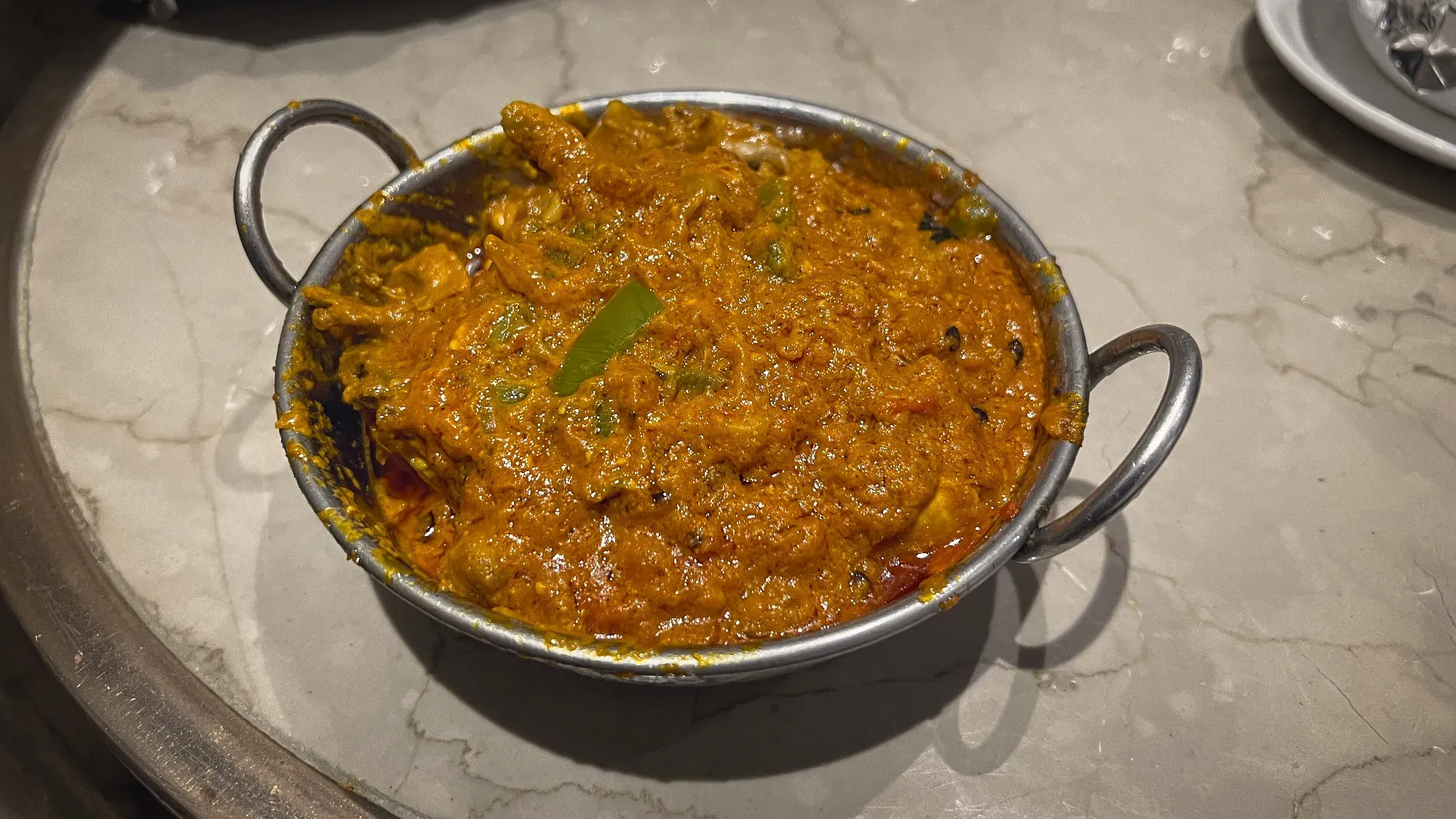
Kadai is a North Indian/Pakistani, tomato-based curry with onions, chilies, and a mix of spices that can vary wildly between each cook. The name kadai refers to the Indian wok that the dish is prepared with. It is popular for its flexibility with any protein source and a wide range of personal masala combinations, all you need is a wok.
Korma (Qorma)
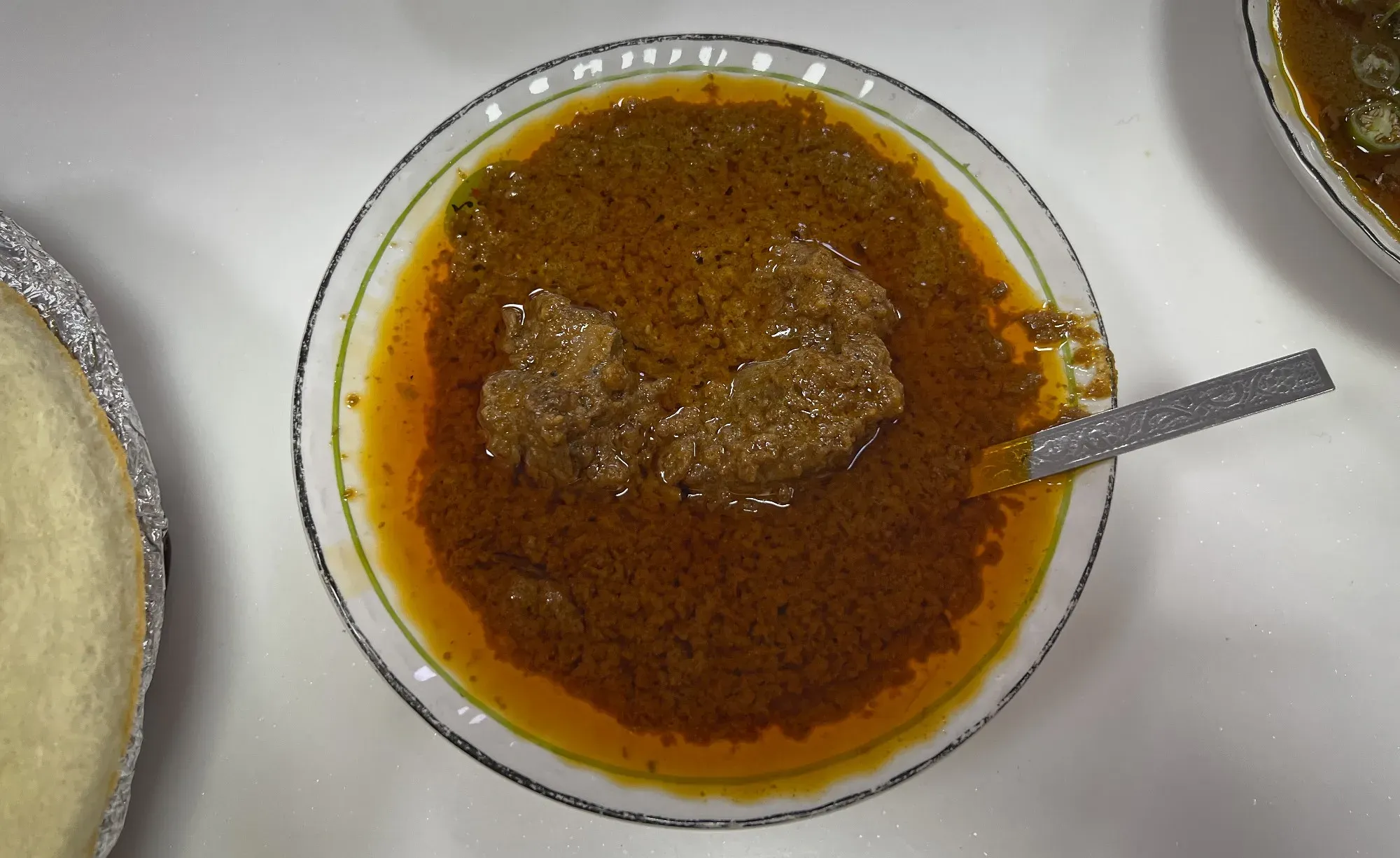
Classically, Korma refered to a dish where meat of vegetables were braised with yogurt or stock. Now, the korma style is defined by searing a meat or vegetable using a high heat and then slow cooking with a "moist" heat (yogurt or stock still commonly used, just a minimum amount). The slow cooking dum process can be used here effectively. Korma can also be finished with a technique called bagar. To perform bagar, when nearing the end of the cooking process, additional spices are flash cooked with ghee and combined with the original braising sauce. This combination is then shaken and added with the meat / vegetable. While korma uses many of the same ingredients as the other curries in this list, the use of these different preparation methods yield entirely different textures and flavors.
Nihari
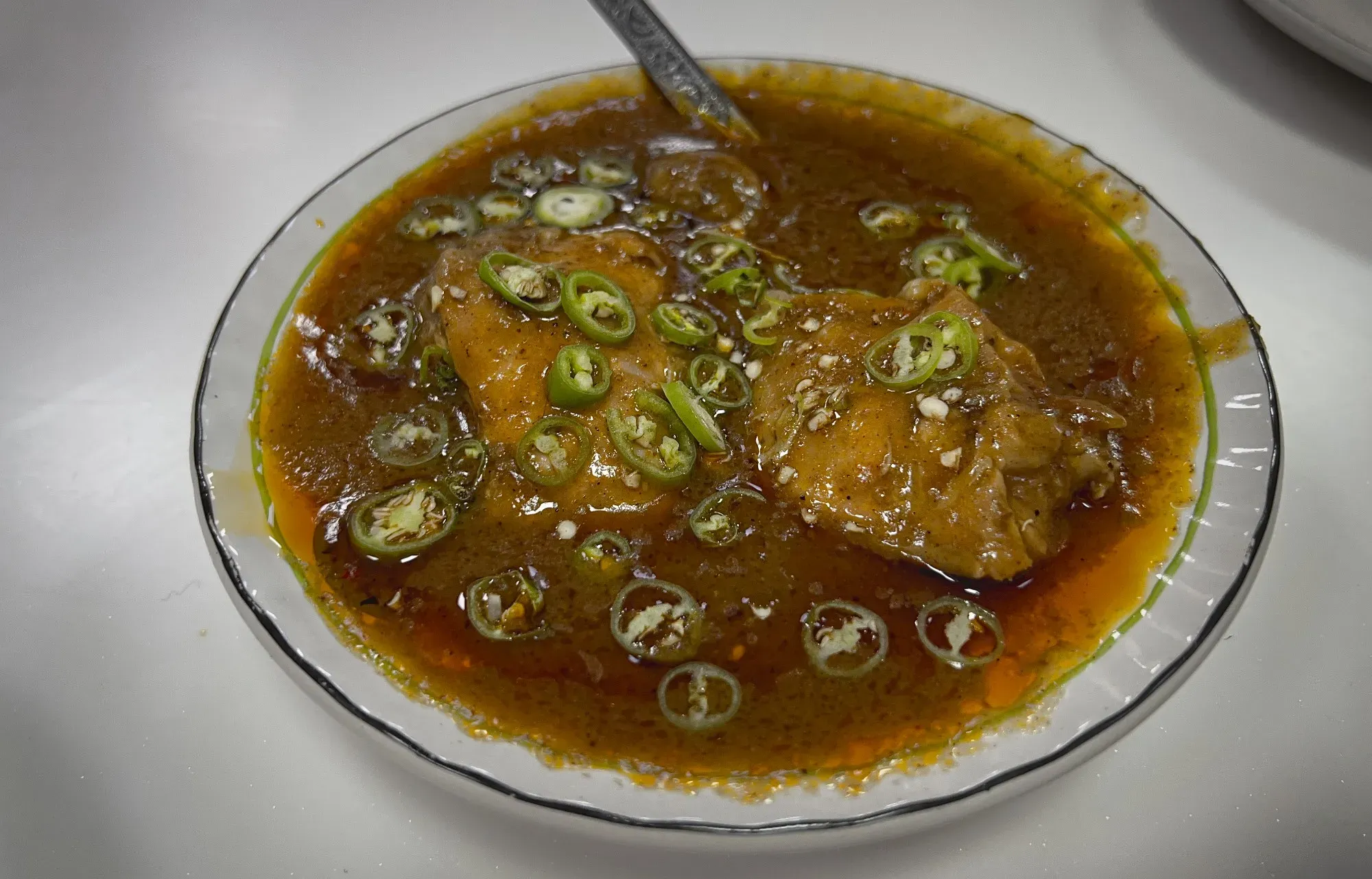
Nihari is a stew from Lucknow in Uttar Pradesh. It is now popular throughout both Pakistan and Northern India, especially in Delhi. The stew is made with flour and a variety of spices (long pepper, fennel seeds, cumin seeds, corrander seeds, cardamom, cloves, oil, etc.). The main components of the dish are a slow-cooked meat (usually mutton, sometimes chicken) and plentiful chopped chilies.
Chana Masala (Chole Masala)
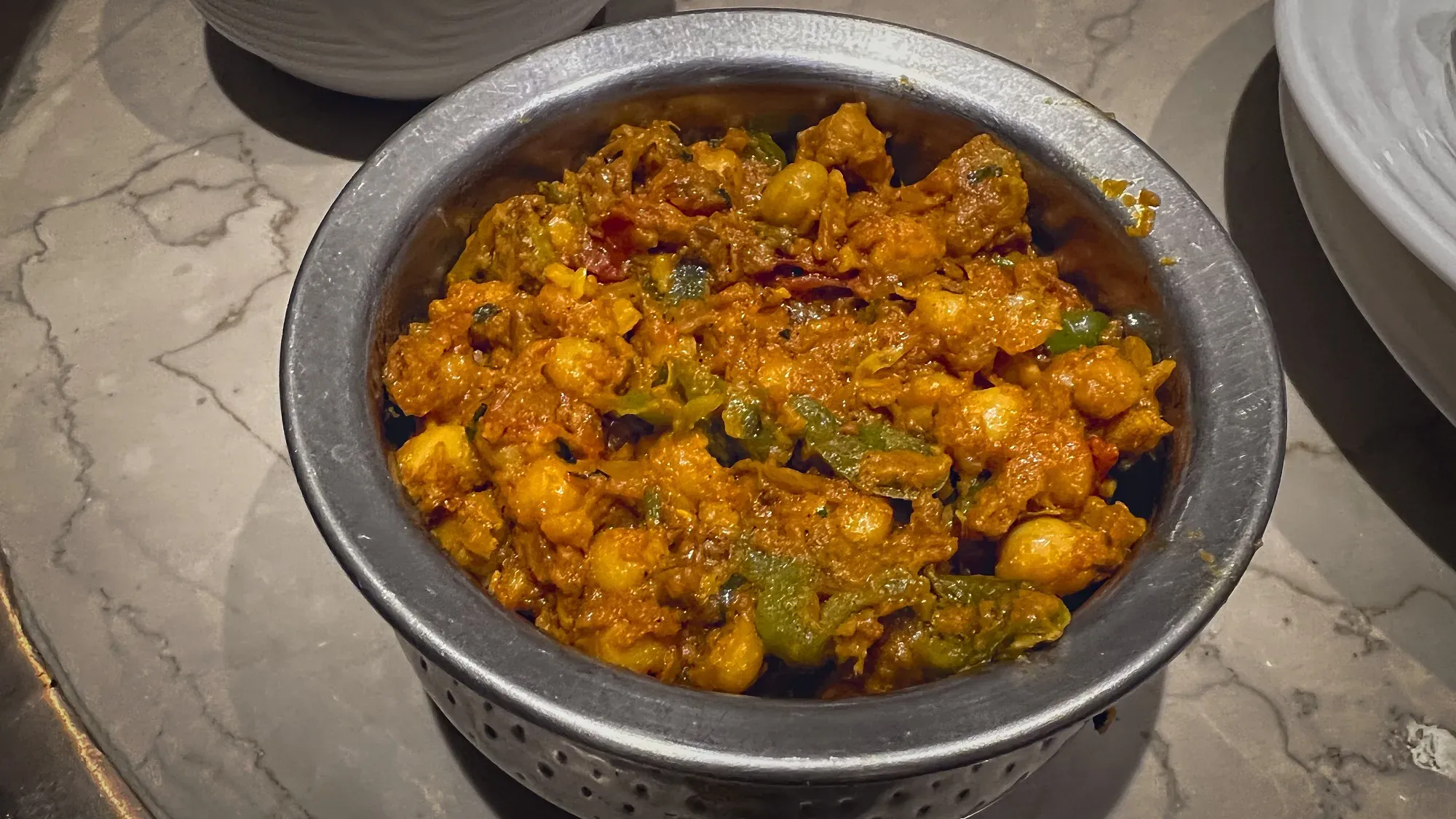
Chana Masala is an extremely popular chickpea curry from Punjab. It has spread to encompass a large range of styles, ranging from a dry curry packed with chilies to a mild chickpea stew. However it is prepared, it is a tasty chickpea entree that can work as a street food snack or a meal centerpiece.
Rajma Chawal
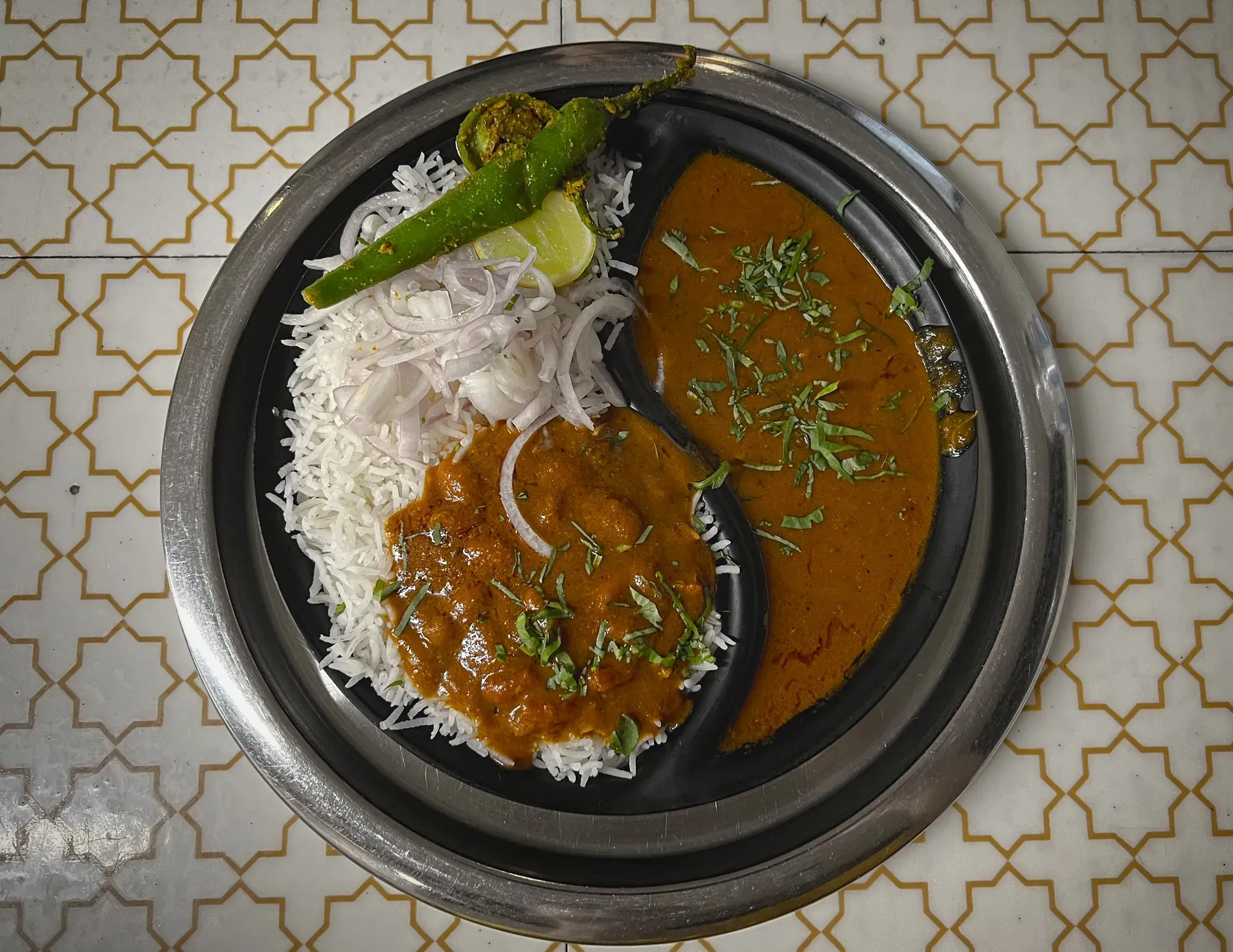
Rajma Chawal is a popular North Indian dish made from kidney beans (rajma) cooked in a rich and spicy tomato-based gravy, served with steamed rice (chawal). The kidney beans are soaked overnight and then cooked with onions, tomatoes, ginger, garlic, and a blend of aromatic spices like cumin, coriander, and garam masala. The dish is typically garnished with fresh cilantro and served hot with steamed rice.
Laal Maans
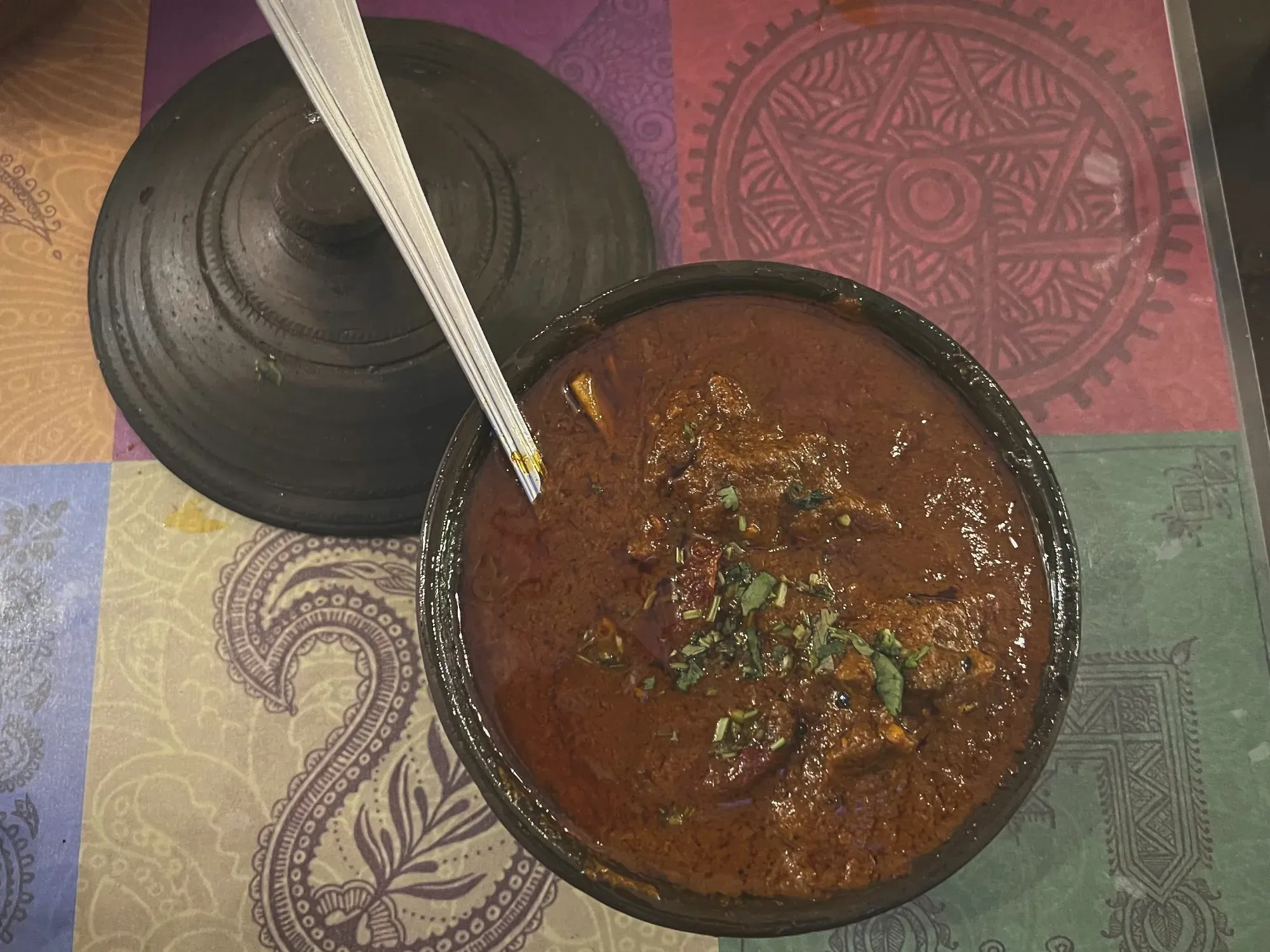
Laal Maans is a fiery and flavorful meat curry that originates from the Rajasthan region of India. The dish gets its name from the bright red color of the gravy, which is achieved by the use of Kashmiri red chili powder. Laal Maans is traditionally made with mutton, which is slow-cooked in a blend of aromatic spices like cumin, coriander, cardamom, and cinnamon, along with garlic, ginger, and onions. The gravy is rich and creamy, thanks to the addition of yogurt and cream.
Laal Maans is a signature dish of Rajasthani cuisine and is often served during special occasions and festivals. It is the Rajasthan version of a Rogan Josh, but Laal Maans uses the spicier red mathania chilies (and of course a slightly different flavor profile and history).
Ghewar
Ghewar is a traditional dessert originating from the Indian state of Rajasthan. It is a disc-shaped sweet made from all-purpose flour, ghee, and sugar syrup. The batter is poured into a circular mold and deep-fried until crispy and golden. The fried discs are then dipped in a sweet syrup made from sugar and water, which gives the dessert its characteristic sweet and syrupy flavor. Ghewar is typically served during the Teej festival, which celebrates the arrival of the monsoon season in Rajasthan. It is also a popular dessert during other festivals such as Raksha Bandhan and Diwali.
Falooda / Kulfi Falooda
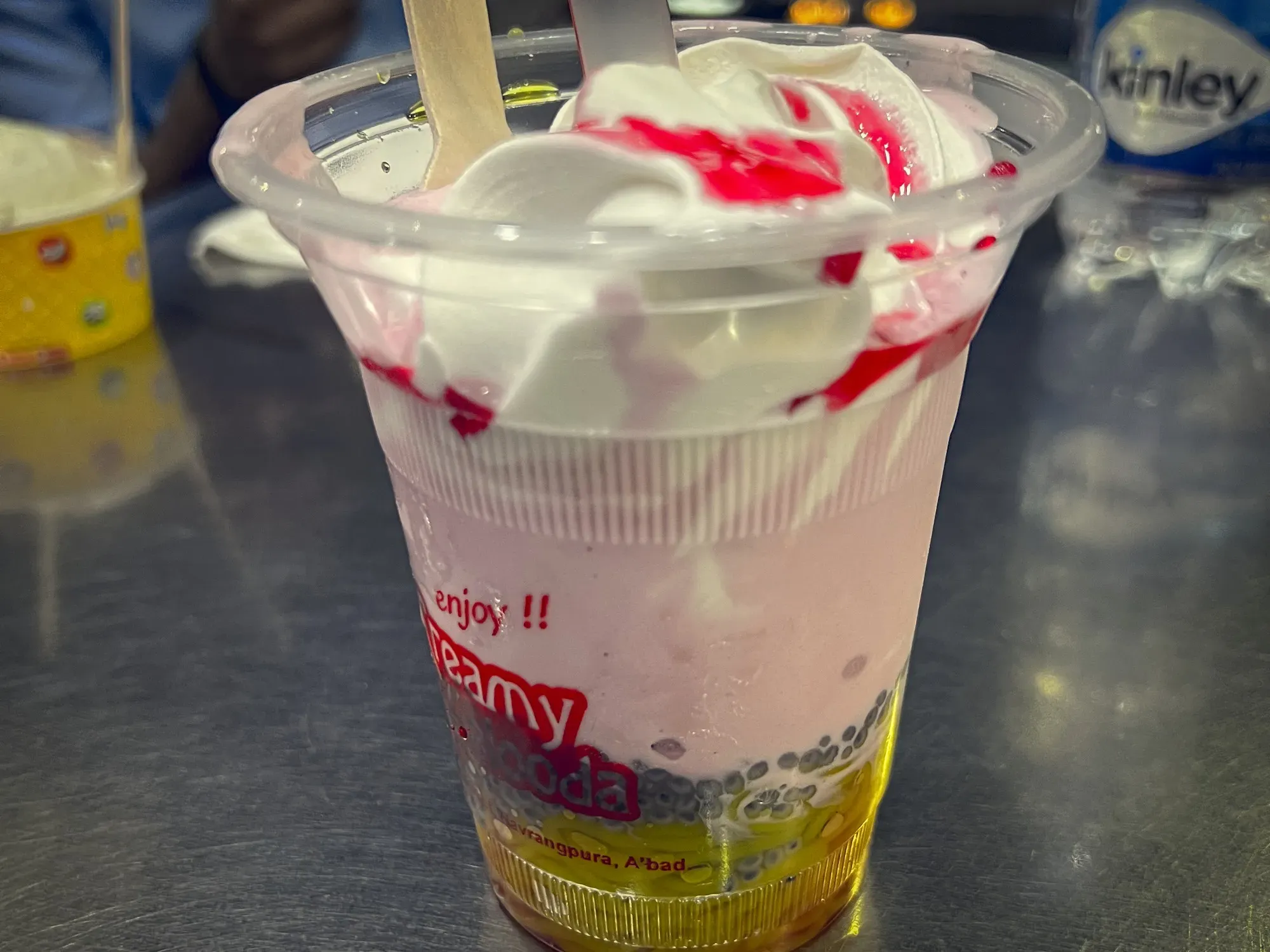
Falooda is a Indian cold dessert made with vermicelli noodles. Brought from the Mughals with a strong Persian influence, the drink has become iconically popular throughout India. The drink involves vermicelli, sweet basil seeds, and rose syrup. Oftentimes it is topped with kulfi, or Indian ice cream: kulfi falooda.
Moong Al Halwa
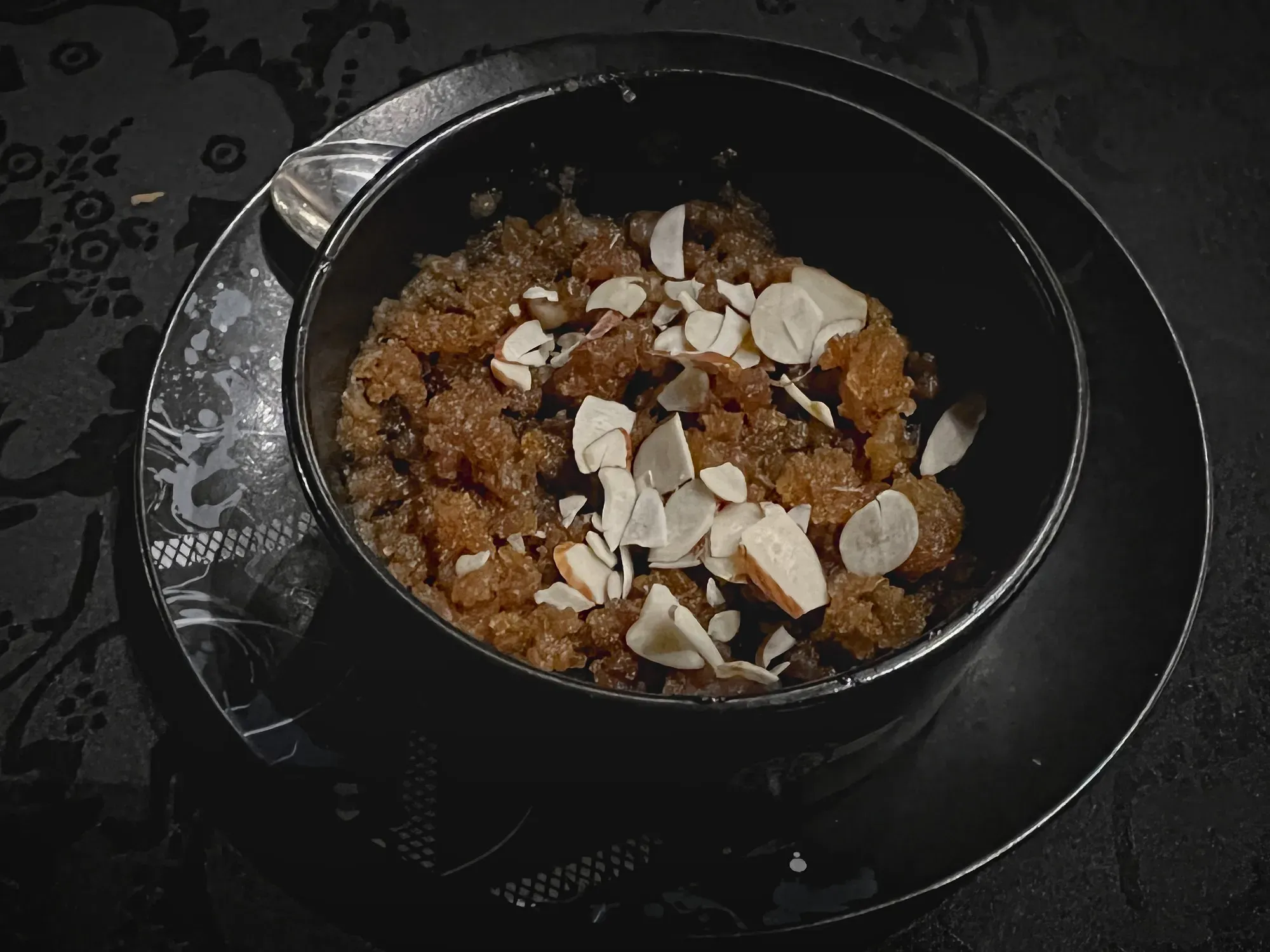
Moong Al Halwa is a traditional Indian dessert made from moong dal, ghee, sugar, milk, and cardamom powder. Moong dal is a type of lentil commonly used in Indian cuisine, and the halwa is made by grinding the dal into a fine powder and roasting it with ghee until it turns golden brown. Milk and sugar are then added to the mixture and cooked until the halwa thickens and the ghee starts to separate. The dish is finished with a sprinkling of cardamom powder, which adds a sweet and spicy flavor.
Moong Al Halwa originated in Rajasthan, a state in North India known for its rich and flavorful cuisine. It is traditionally served as a dessert during special occasions and festivals like Diwali and Holi. The dish is also believed to have medicinal properties and is often recommended as a remedy for colds and coughs. Today, Moong Al Halwa has become a popular dessert across India and is often served in restaurants and at weddings and other celebrations.
Gajar Ka Halwa (Carrot Halwa)
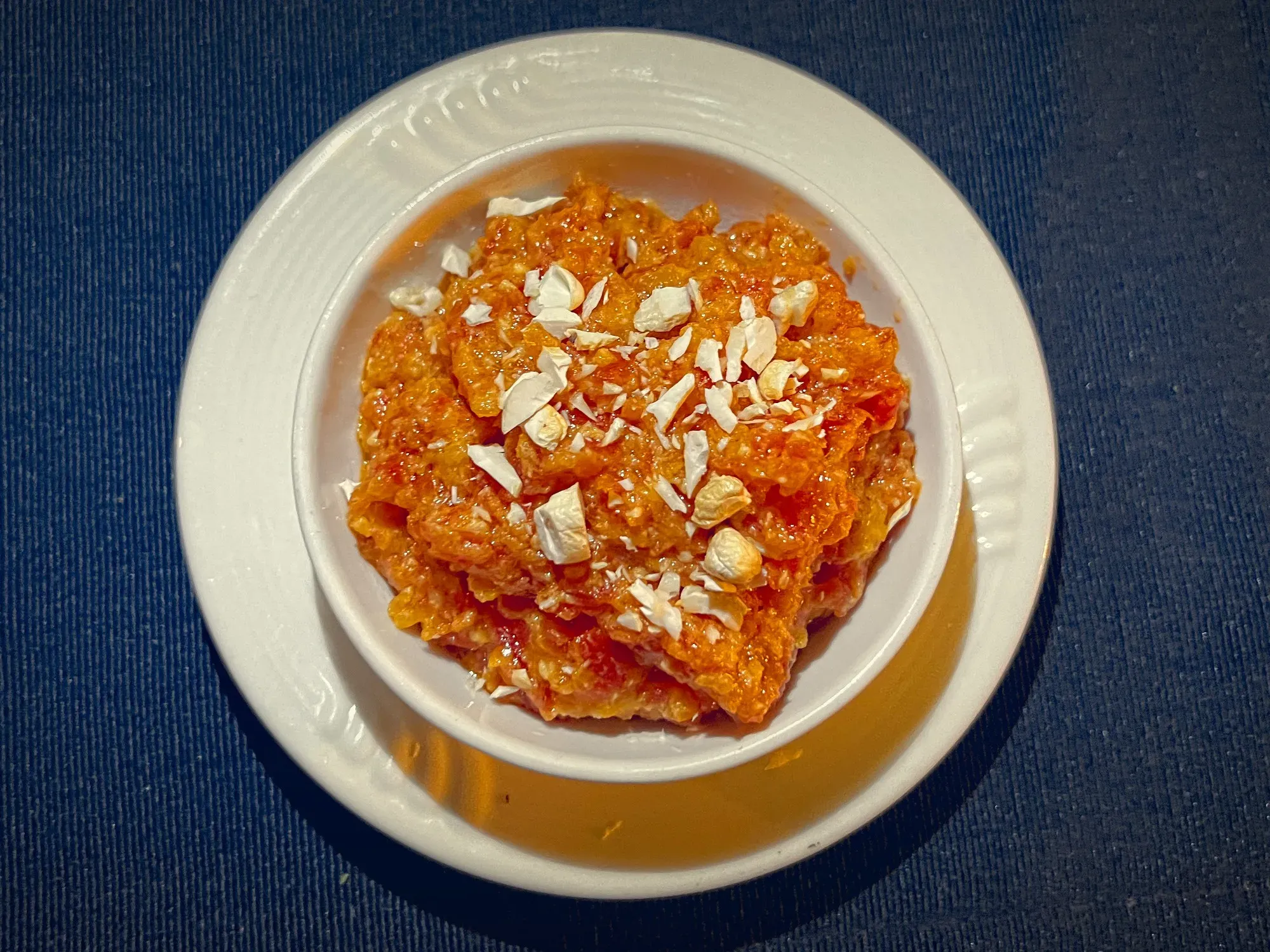
Carrot Halwa, also known as Gajar Ka Halwa, is a popular dessert in India made from grated carrots, milk, ghee, sugar, and cardamom powder. The grated carrots are cooked in ghee until they are tender and then mixed with milk and sugar, which are simmered until the mixture thickens and the milk is absorbed. The dish is then finished with a sprinkling of cardamom powder and garnished with nuts like almonds and cashews.
Carrot Halwa originated in Northern India, particularly in the state of Punjab, where it is often served during winter months when fresh carrots are in season. It is also a popular dessert during festivals like Diwali and Holi. Carrot Halwa has become a beloved dessert in Indian cuisine and is enjoyed across the country and beyond. It is often served warm with a dollop of vanilla ice cream, making for a delightful combination of flavors and textures.
Kashmiri Dum Aloo
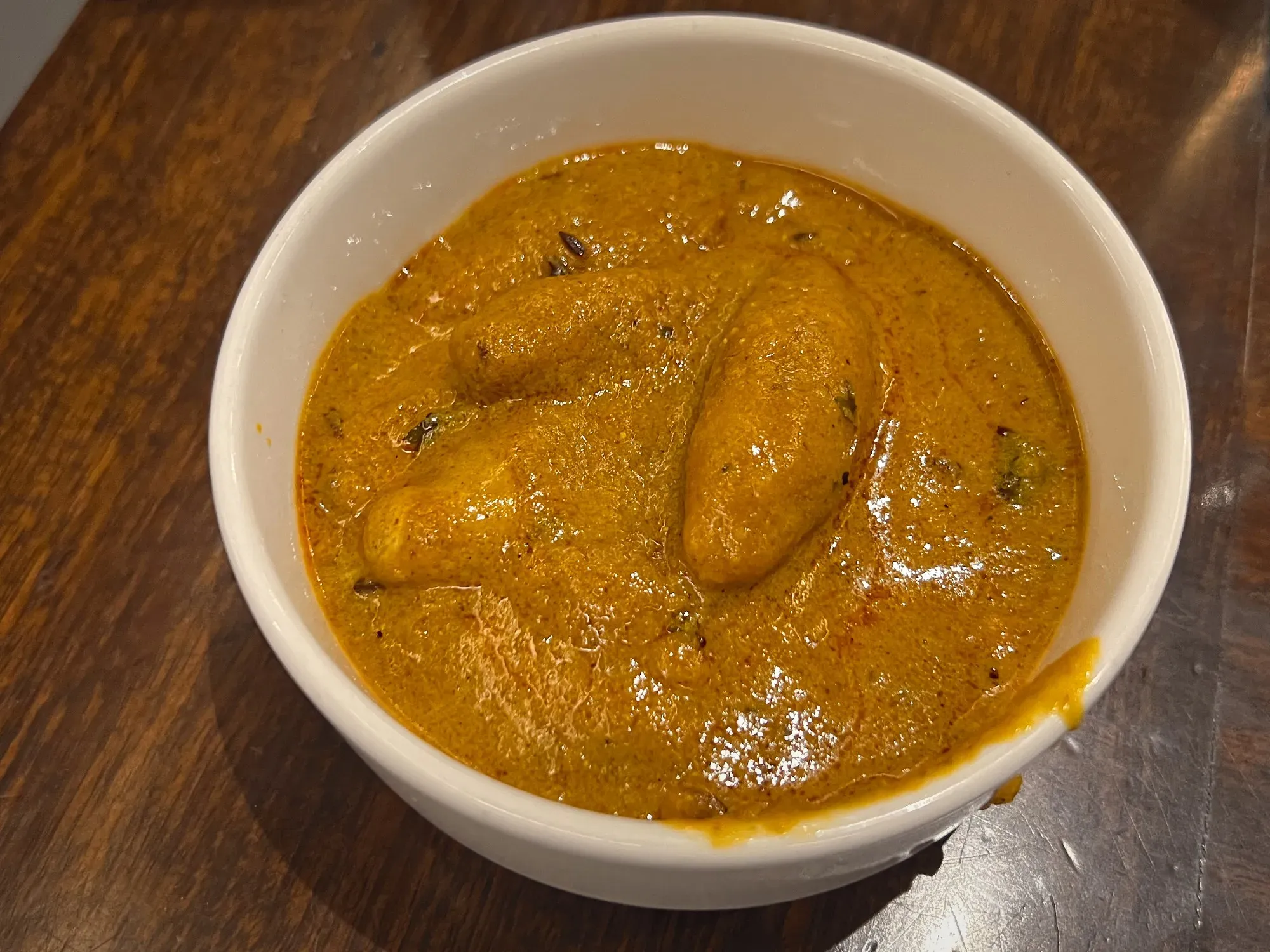
Kashmiri Dum Aloo is a classic North Indian dish that originated in the Kashmir valley of India. The dish is made using baby potatoes that are first boiled and then fried until they are golden brown. The potatoes are then simmered in a rich tomato and yogurt-based gravy, which is flavored with a blend of aromatic spices such as fennel seeds, ginger, and Kashmiri red chili powder. The dish is typically garnished with fresh cilantro and served with hot naan or rice.
Gatte Ki Sabji
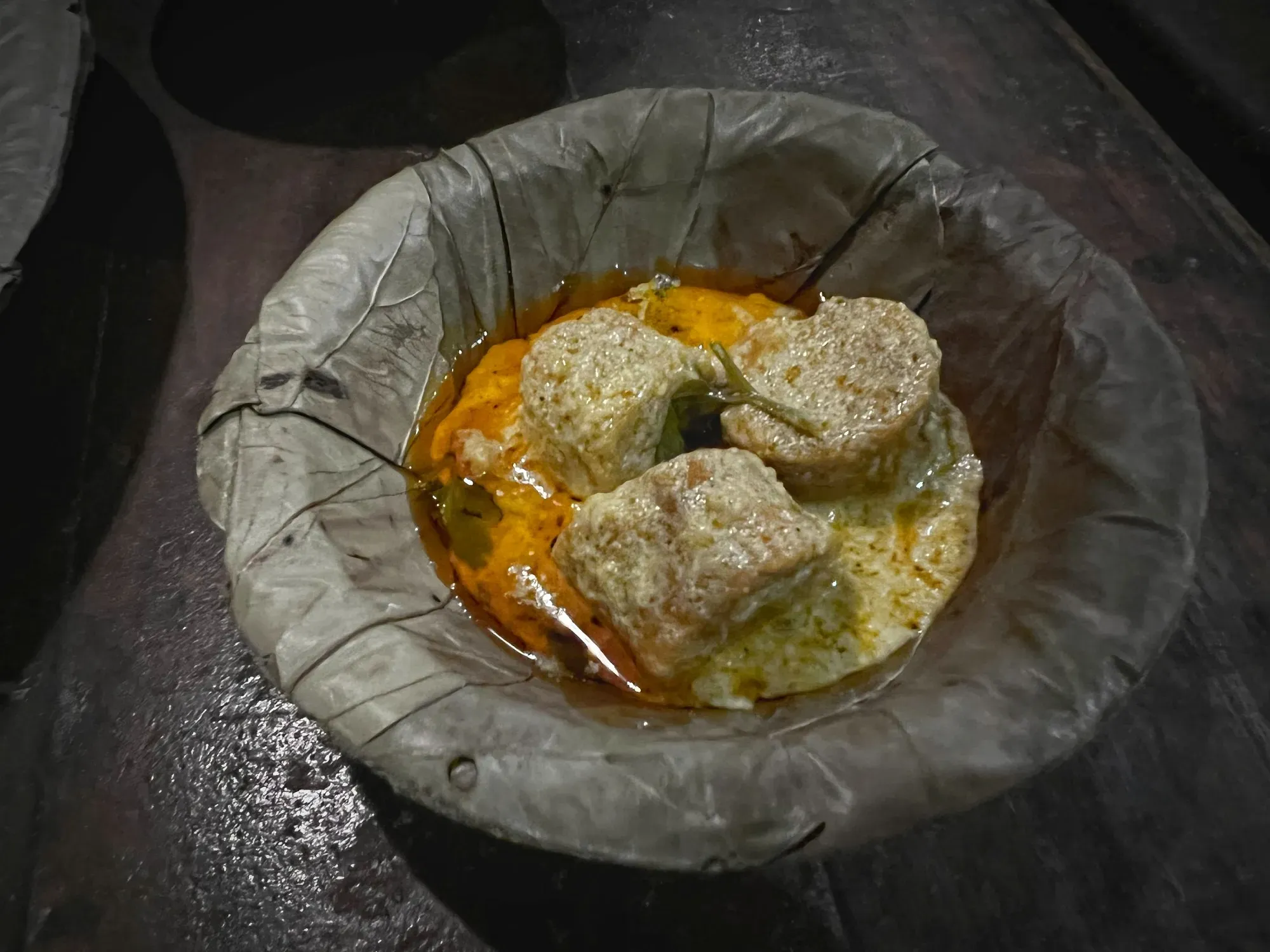
Gatte Ki Sabji is a traditional Rajasthani dish made from gram flour dumplings (gatte) cooked in a spicy and tangy yogurt-based gravy. The dumplings are made by mixing gram flour, spices, and oil, and kneading them into a stiff dough. The dough is then shaped into cylindrical logs, which are boiled and sliced into small pieces. These pieces are then added to the yogurt-based gravy, which is flavored with spices like cumin, coriander, and red chili powder.
List of Other Things to Try:
- Mughlai Dum Paya - Paya is a goat's hoof. Very popular in certain regions.
- Seekh Kabab - ground meat is mixed with a blend of spices and formed into kebabs to grill
- Amritsari Fish - Punjabi deep fried fresh-water fish
- Dahi Vada - fried lentil fritters in a yogurt sauce
- Aloo Tikki - snack of fried potato patties
- Baigan Barta - Punjabi eggplant mash curry
- Papad Ki Sabji - Gatte Ki Sabji but with papad instead of the gram flour dumplings from Rajasthan
- Ragda Pattis - a dish of mashed potato patties and pea sauce, and is part of the street food culture in the Indian state of Maharashtra
- Aam Ka Murabba - unripe mango preserve
- Besan Ka Cheela - savory Indian pancake recipe made with gram flour, onions, tomatoes, herbs and spices
- Mawa Misri - unique Jaipur dessert
- Macchhili Jaisamandi - fish dish from Udaipur
Resources
Restaurant Recommendations
India is so large and populated, with incredible hole-in-the-wall restaurants around every corner. Food culture is so strong in this country, and any random local restaurant has the possibility to blow your mind with the chefs personal spice blend. Therefore, I will stick to just a few more popular and famous restaurants in the Delhi and Rajasthan area.
To start off, Indian Accent in Delhi is an Asia's 50 Best Restaurant that lives up to its reputation. The food here is definitely a modern translation of Indian, but it is incredibly creative and delicious. One of my favorite "fancy" restaurants for sure. Darbar is a local chain Northern India that has a large repertoire of phenomenal vegetarian dishes. Their Makke Ki Roti made me want to return every day in the winter.
Chokhi Dhani is a full Rajasthan experience more so than a restaurant, but they have a Rajasthan Thali dinner that is worth the trip itself. What a fun time for a family to see cultural re-enactments and get a delicious Rajasthani culinary overview.
Udaipur is a tourists dream. Cute hotels and hostels all along the lake in a walkable area, overflowing with top-tier restaurants with a view. Hari Garh Restaruant is one of these restaurants that not only serves scrumptious dishes, but has couch seating overlooking the lake in one of the cutest possible configurations. It was such a treat just to be here, and the food left one in pure bliss. Upre, right down the street, is possibly the closest to a perfect restaurant I've ever been to. Phenomenal service, a gorgeous view over the lake, comfortable seatig heated by aesthetic heaters next to each table, excellent renditions of a few of the dishes on this list, all for a suprisingly reasonable price. I cannot recommend it enough. Absolute must visit restaurant if you are near Udaipur.
To see an extensive list of restaurant recommendations in India, check out the Restaurants page to see a map of our top recommendations for Asia as well as the database with details on restaurants from all around the world.




